Automobile is a wheeled machine that serves as the most important form of transportation in the world. People drive about 1 billion passenger cars along the world’s roads and highways—about 1 car for every 8 people. Trucks transport huge amounts of food, clothing, and other products across vast distances. Since their invention in the late 1800’s, automobiles have shaped the way people do business and live their lives. Few technologies have changed the world as much as the automobile has.
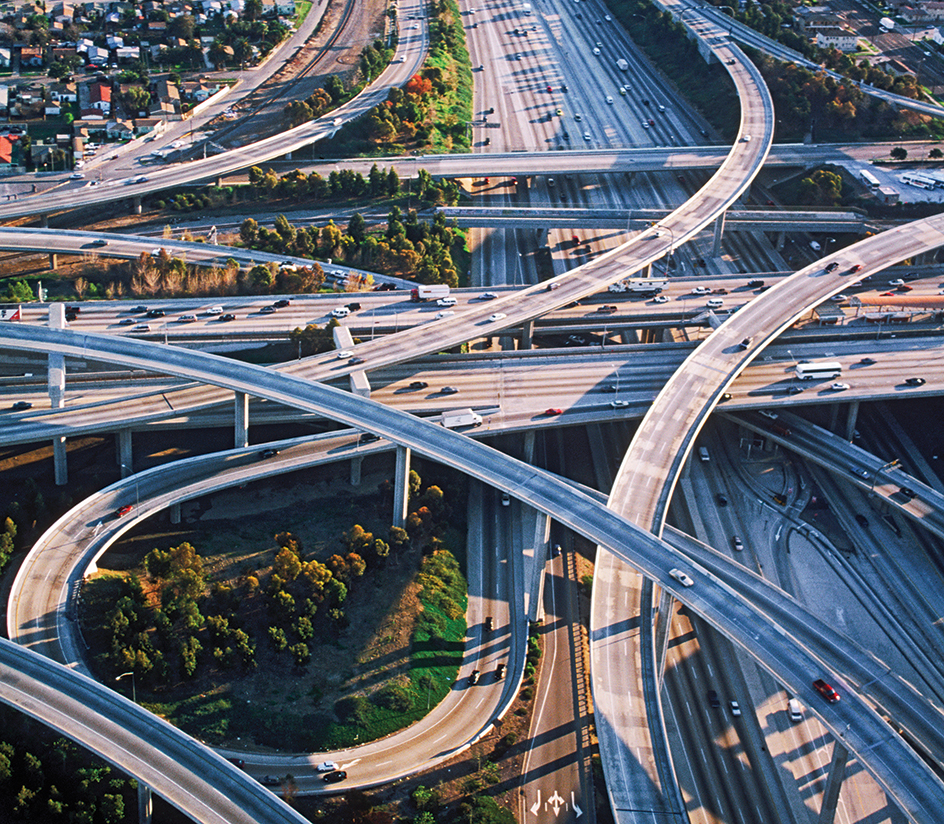
A car moves by producing power and channeling it to the wheels, spinning them. Like the human body, a car includes a number of systems that work closely together. Each system is itself a complex machine. Most systems in an automobile have many moving and computerized parts. Some systems work to produce power or transfer it to the wheels. Others work to support the car or provide information to the driver.
All cars use energy to power their motion. Most cars have internal-combustion engines. Such engines use energy stored in gasoline or diesel fuel by burning it. Other cars have an electric motor. The motor uses energy stored in a rechargeable battery. Hybrid cars combine an internal-combustion engine with an electric motor.
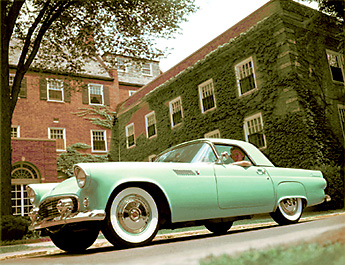
Manufacturing a car requires years of planning. Engineers use computer programs to model how the car will look and perform. They build sample cars and test how well the samples work in a variety of conditions. All the parts of the car must be made from scratch or bought. Then, automakers bring the parts together on an assembly line. An automobile assembly line is a row of workers. Each worker performs an assigned task, such as inserting a part. The car then passes along to the next worker until it is finished.
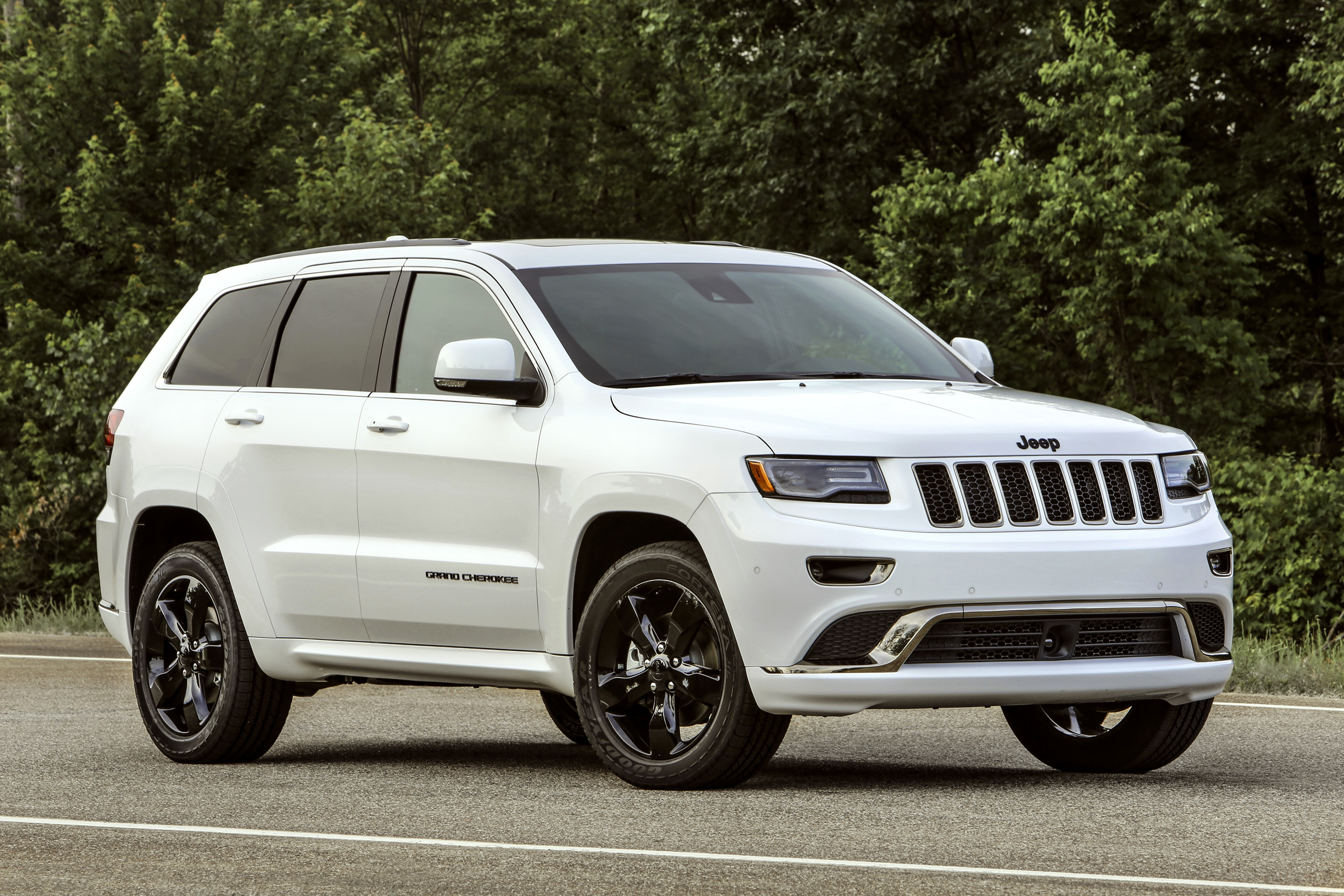
Auto manufacturers and related industries employ millions of people throughout the world. This fact causes the health of the auto industry to be closely tied to the health of the world economy. The popularity of automobiles has given rise to vast networks of highways. Gas stations, motels, and fast-food restaurants owe their existence to the popularity of the automobile.
Automobiles also have their disadvantages. Millions of people have died in car accidents. The construction of car-friendly roads and cities has destroyed or displaced many natural habitats. Cars also cause pollution.
The history of automobiles was shaped by many inventors, engineers, and businesspeople. Cars were once too expensive for most people. But they became cheaper and more plentiful after the introduction of mass production. Mass production involves the use of interchangeable parts, machines, and moving assembly lines to produce large quantities of nearly identical goods. By the late 1920’s, a few large companies came to dominate the car market.
In the early 2000’s, relatively new markets for cars—such as China and India—were growing fast. But the auto industry, shaken by a global recession, struggled to adapt to demands for greater fuel efficiency and less pollution. Changing consumer preferences, safety concerns, and government regulation reshaped automobile designs and reduced the dominance of the big car companies.
Automobile systems
When a driver steps on an automobile’s gas pedal, the car accelerates. This action and reaction may seem simple. However, a number of complex systems—each consisting of many moving parts—must work together to make it happen. The car’s power system, connected to the gas pedal, generates motion within the vehicle. The power train—which includes the transmission and the drive system—channels this motion from the car’s power system to spin its wheels. Meanwhile, the car’s support system holds the car’s frame up from the wheels. Steering and brake systems enable the driver to control the moving car. The electrical system connects most of the other systems together.
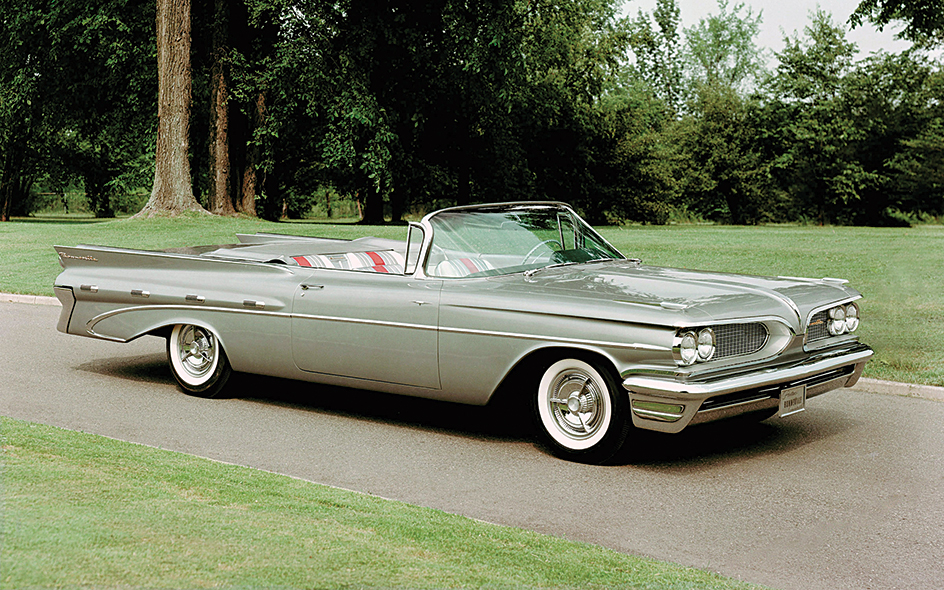
All of a car’s systems use a number of technologies and scientific principles to work. Physical laws govern the spinning, pushing, and pulling motions of a car’s engine, axles, wheels, and other internal parts. Hydraulics—a branch of physics involving pressure from fluids—plays a major role in steering and brake systems. Most modern cars rely on electronics and advanced computer technology to coordinate their systems.
Power systems.
A car’s power system consists of one or more power plants. A power plant is a machine that generates power. Power plants generate electric power for a car’s lights and computerized parts. But their main purpose is to generate power for spinning the wheels. There are two main kinds of power plants in modern automobiles: (1) internal-combustion engines and (2) electric motors.
Internal-combustion engines generate power from the energy stored in fuel. Gasoline and diesel are the most common engine fuels. They are made from petroleum. Petroleum is called a fossil fuel because it comes from the fossilized remains of long-dead plants. Some engines can use biofuels. Biofuels are made from plant crops. Other engines use propane, natural gas, or hydrogen as fuel.

Electric motors generate power from large batteries. Several forms of batteries are available in modern cars. They include lead-acid, nickel, and lithium batteries.
Both fuel and batteries are extremely dense energy sources. They can provide enough power for long drives without taking up much space or weighing down the car.
From power plant to wheels.
The power train, also called the drive train, connects a car’s power plant to the wheels. It channels the motion generated by the power system through a series of connected moving parts. Eventually, the motion reaches the wheels and spins them to make the entire car move. The power train consists of two main systems, the transmission and the drive system.
The transmission
regulates the spinning motion generated by the power system before it reaches the wheels. The transmission gets power from the spinning motion of the flywheel, a heavy disc connected to the car’s engine or motor.
In physics, spinning objects—such as flywheels—have two related characteristics: speed and torque. Speed is simply the rate at which the wheel rotates. Torque refers to the strength of twisting force. Within the car, torque tends to drop as speed increases, and vice versa. The transmission varies the amounts of torque and speed from the flywheel using devices called gears.
One way to think about the relation between speed and torque is to consider wrenches. A person might use two different wrenches to loosen a nut by rotating it. To start, the person uses a long-handled wrench. It is easier to turn a tight nut with a long-handled wrench, because such a wrench provides more twisting force or torque. But once the nut loosens and becomes easier to spin, less torque is required to rotate it. The person would then switch to a short-handled wrench to spin the nut at a faster rate. The short handle can spin faster because it has to rotate a shorter distance than the long handle.
The transmission’s gears work much like wrenches with different-sized handles. A stopped car, like a tight nut, requires a large amount of torque to begin moving. The first gear, also called low gear, provides the greatest torque and so is used to start moving a car. But like a long-handled wrench, the first gear sacrifices speed for its high torque. As the car moves faster, less torque is needed. Thus, the transmission switches to higher gears. Like the short-handled wrench, higher gears spin faster with less torque.
Switching from lower to higher gears enables a car to use power more efficiently. Most cars have one reverse gear and from three to five gears for moving forward. A car with an automatic transmission switches gears automatically. Such cars use a computer system to sense the ideal gear for the car’s motion. In a car with a manual transmission, the driver has to switch between gears. To do so, the driver presses down a pedal called the clutch. The clutch disengages the transmission from the car’s power plant. The driver then moves a leverlike device called the gearshift to change between gears.
The drive system
carries power from the transmission to the set of wheels that moves the car. Depending on the automobile, these may be the front wheels only, the back wheels only, or all four wheels.
In a car with front-wheel drive, the front wheels not only steer the car but also drive it. Such cars combine the engine, transmission, and differential under the hood. The differential is a set of gears connected to the transmission. In a turn, it enables an outside wheel to rotate faster than an inside wheel. The differential is necessary because through a corner, the outside wheel must travel farther than the inside one. A short bar called a half shaft transfers power from the differential to the wheels.
Cars with rear-wheel drive have a long drive shaft that transfers power to the back wheels. The differential is in the back of the car. Rear-wheel drive cars have better weight distribution, which can improve the car’s handling. 
Four-wheel drive vehicles deliver power to all four wheels. A device called a transfer case distributes the power between the front and rear wheels. Driving with all four wheels provides good traction on rough or slippery terrain.
Front-wheel drive cars can be cheaper and more compact than other types. They also require less power. Most passenger cars and vans have front-wheel drive. Pickup trucks, commercial vans, and sports cars typically use rear-wheel drive. Vehicles with four-wheel drive include some sport utility vehicles (SUV’s) and light trucks.
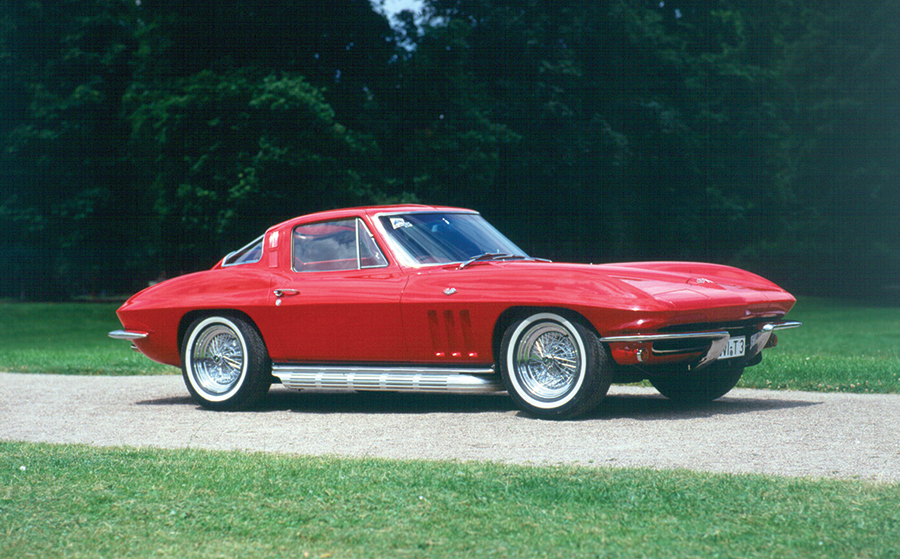
Controlling the car.
Two main control systems enable a car’s driver to navigate the road. They are the steering system and the brake system.
The steering system
controls the front wheels. The driver operates the system with the steering wheel. The steering wheel connects to the car’s front wheels through the steering shaft. Turning the steering wheel causes gears at the bottom of the shaft to turn. The gears, in turn, connect to the car’s wheels.
Most cars have power steering, which enables drivers to more easily turn the vehicle’s wheels. Power steering uses a hydraulic system, which produces pressure from a fluid, to help move the wheels.
The brake system
slows or stops an automobile. Cars have brakes on all four wheels. The brake system relies on hydraulic pressure. When a driver steps on the brake pedal, fluid goes through lines connected to each wheel. In disc brakes, pressure from this fluid forces a pad to rub against a disc attached to the moving wheels. The resulting friction slows or stops the wheels. All cars have disc brakes on their front wheels. Some cars have another kind of brake, called drum brakes, on their back wheels. The parts that rub against each other are shaped differently in drum brakes.
Power brakes make it easier to force fluid through the brake system. Power brakes use the difference in pressure between the air in the engine and the air outside to squeeze the brake fluid faster. They make it easier to push down the brake pedal. But they do not stop a car any faster than regular brakes.
Many cars have an antilock-braking system. Such a system prevents the wheels from locking up entirely during braking, helping to prevent skidding. It is especially useful on wet roads. A computer varies pressure on the brakes, preventing lockup.
Supporting the car
involves tires, wheels, axles, and the suspension system. In the past, a rectangular steel frame on the bottom of the car supported the rest of the car’s weight, much as a skeleton supports the weight of a body. Today, however, most cars do not have a separate body and frame. Instead, their entire structures are welded together.
The suspension system helps smooth the ride of passengers and cargo over twists and bumps in the road, somewhat as shoes protect a person’s feet. The system keeps the wheels in contact with the road. But it allows them to move up and down with holes or bumps in the road surface without shaking the entire car.
Most suspension systems consist of springs and devices called shock absorbers, also called shocks. As a tire hits a bump, the wheel is forced upward, and the spring and shock are compressed. As the road levels out again, the spring and shock rebound, forcing the wheel back down.
The passenger compartment,
sometimes called the cabin or cab, is the area of a car or truck in which people sit. It contains seating and the pedals and steering wheel that the driver uses to control the car. It also has a number of other systems that provide comfort, convenience, or information to the people in the car.
The dashboard, a panel under the windshield, houses important displays and controls. Instrument readouts above the steering wheel typically display information about the car’s performance. For example, the speedometer displays a car’s speed. The odometer records the total distance a car has been driven. A fuel gauge tells how much gas remains in the tank. Many cars also display information about oil pressure, battery voltage, and engine temperature. Dashboards may also house warning lights that alert drivers to problems with the car’s parts or systems.
Virtually all cars have a heater. It blows air warmed by engine heat into the interior of the vehicle. Most cars also have an air conditioner, which draws on engine power to circulate cool air.
Other devices accessible on the dashboard include audio equipment and computerized displays that help give directions. Controls for power door locks, windows, and mirrors are typically on the inside of the doors. Levers near the steering wheel control the car’s turn signals, windshield wipers, and headlights. Many cars also have a computerized mechanism called cruise control. Cruise control keeps the car moving at a set speed without the driver having to step on the gas.
Almost all automobiles are equipped with safety features, notably seat belts and airbags. Seat belts restrain passengers if a car crashes. An airbag is a bag that rapidly fills with gas in a collision, acting to cushion the passengers. Without such safety features, passengers in a collision would be thrown from their seats and smash into the windshield, dashboard, steering wheel, or seat backs, causing injuries or deaths.
Providing electric power.
A car’s electrical system ties many of its other systems together. It typically controls the starting and ignition systems, the lights, and the devices and displays inside the passenger compartment.
A 12-volt battery stores energy to start the car. This action cranks the engine to life. The engine, in turn, powers an alternating-current generator. The generator produces power for the electrical system and recharges the battery.
Hybrid vehicles have an additional battery pack, typically above 100 volts. The battery pack provides electric power that turns an electric motor that moves the car. If the battery pack’s charge gets low, the 12-volt battery restarts the internal-combustion engine so the automobile can continue to move.
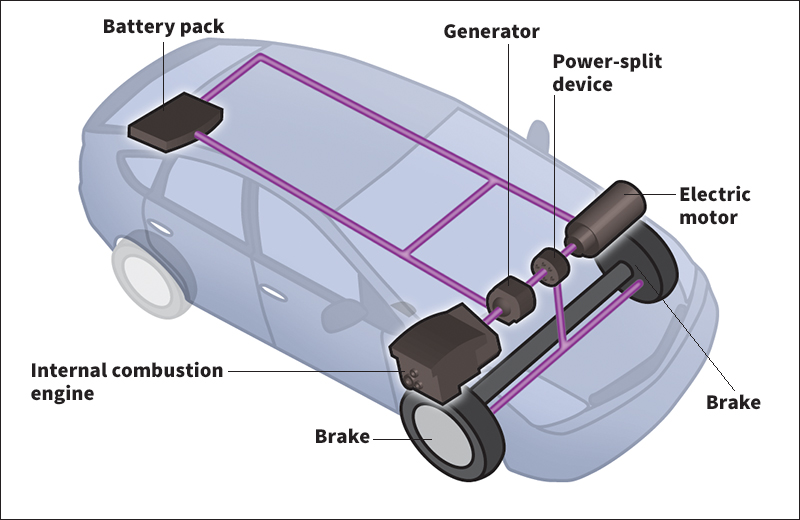
Powering an internal-combustion car
The power system lies at the heart of an automobile. In most cars, it includes an internal-combustion engine. In addition, it includes several subsystems that feed into the engine and help maintain it.
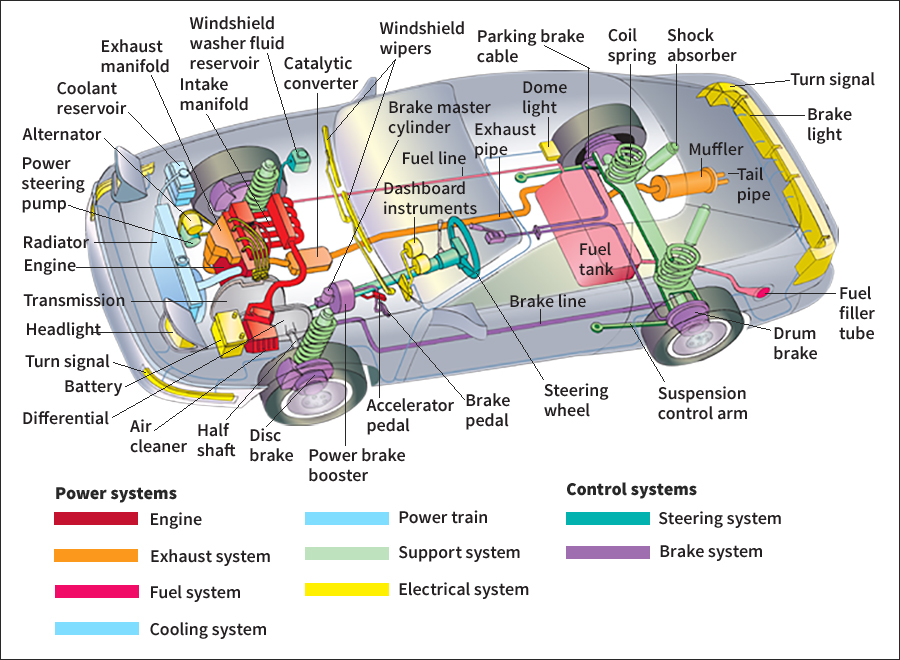
Most automobiles have an engine under their front hood. The engine typically works by burning a mixture of gasoline and air. The explosive force from burning this mixture creates motion in the engine’s parts. This motion makes its way through the power train to spin the car’s wheels. Some internal-combustion engines use diesel fuel or a biofuel instead of gasoline. The term internal-combustion engine refers to the fact that fuel is combusted (burned) inside the engine.
Loading the player...How a four-stroke cycle gasoline engine works
Both gasoline and diesel engines are housed in structures called engine blocks. Both types operate with similar engine cycles. The cycle starts when a person turns the car’s ignition key. Electric current from the car’s 12-volt battery powers the ignition system, which causes a starting motor to crank the engine. Both gasoline and diesel engines also have the same support systems, including: (1) the fuel system, (2) the exhaust system, (3) the cooling system, and (4) the lubrication system.
The engine block,
also called the cylinder block, houses the engine’s internal parts. In particular, it contains a number of hollow cylinders. Inside the cylinders, solid metal pistons move up and down. The motion of the pistons is driven by the explosive force of burning fuel. The pistons, in turn, drive a spinning crankshaft connected to the car’s transmission.
The number and arrangement of cylinder cavities varies from car to car. Smaller cars typically have from 2 to 5 cylinders. Larger cars can have anywhere from 6 to 12 cylinders. Engines with more cylinders are generally more powerful.
In most cases, the cylinders are arranged either in a straight line or in a V-shaped formation. Engines are named for the number of cylinders and their arrangement. For example, a straight-4 engine has four cylinders in a straight line. A V-8 engine has eight cylinders in a V-shape.
The engine cycle.
In most cars, the engine operates in a four-stroke cycle. The four strokes, or stages, of the cycle are: (1) intake, (2) compression, (3) power, and (4) exhaust.
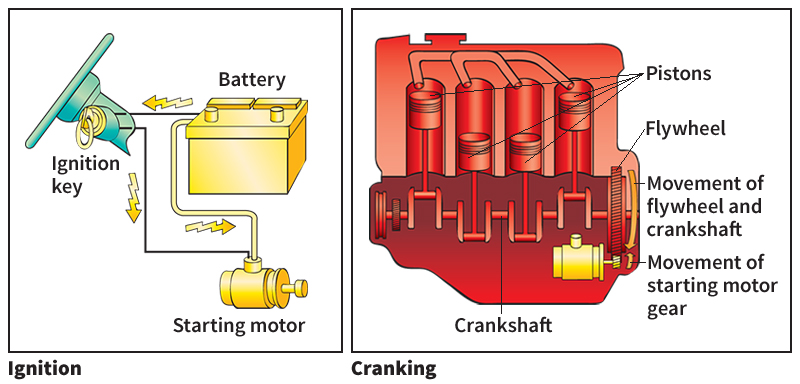
During the first stage—the intake stroke—the piston moves down in its cylinder. At the same time, air is drawn into the empty cylinder cavity. The air enters from an intake valve that opens. In some engines, fuel is also pumped in from the car’s fuel system.
The second stage, compression, begins when the cylinder is full of air. The intake valve closes and the piston moves up the cylinder, compressing (squeezing) the air. Squeezing the air has an effect similar to squeezing a balloon, making it more likely to explode. Fuel may be compressed along with the air, or it may be pumped in separately. In a diesel engine, the mixture explodes on its own. In gasoline engines, electric sparks from spark plugs set the mixture on fire.

The force of the explosion starts the third stage of the cycle, the power stroke. The explosion pushes the piston back down. The burned gases remain in the cylinder cavity.
The fourth stage, exhaust, allows those burned gases to escape through an exhaust valve. The valve opens as the piston moves back up, pushing the burned gases out. The exhaust valve connects to the exhaust system, which cleans the burned gases before releasing them into the open air. With the exhaust stroke complete, the exhaust valve closes, and the cycle starts again from the beginning. The entire four-stroke cycle can take less than a second.
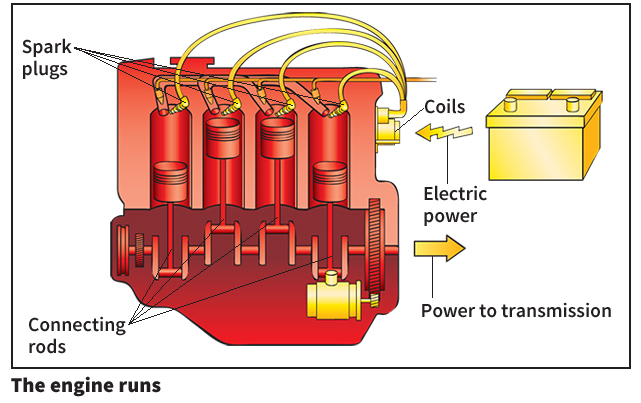
The pistons are connected to the crankshaft. As the piston moves down, it causes the crankshaft to spin—much as the pushing of a foot pedals a bicycle. The spinning crankshaft, in turn, connects to the car’s transmission and causes the flywheel to rotate, along with all the other systems and parts connected to the flywheel. Thus, the up-and-down motion of the pistons creates the motion that eventually spins the car’s wheels. 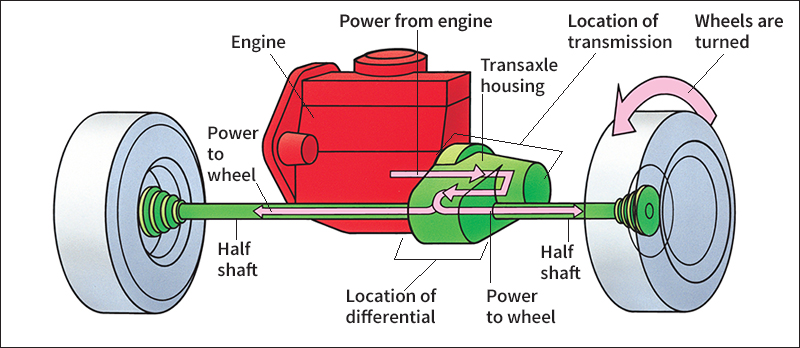
Computers regulate the cycles of modern engines. A control unit gathers data about the engine’s speed, air pressure, temperature, and other factors. It uses this information to control the timing of the spark plugs and the fuel flow. It makes adjustments hundreds of times a minute.
For more information, see the article Gasoline engine. To learn about other types of engines used in some cars, see the articles Diesel engine; Rotary engine; Turbine.
The fuel system
stores fuel in a car’s gas tank, prepares it for use, and transports it to the engine. Most fuel tanks hold from 12 to 20 gallons (45 to 76 liters). They are made of steel or plastic. Before the fuel can be burned in the engine, the fuel system must first transform it into fine droplets, and then into a gas that can mix with air.
Older cars used a device called a carburetor to create a mixture of fuel and air in the cylinders. But carburetors were inefficient and caused much pollution.
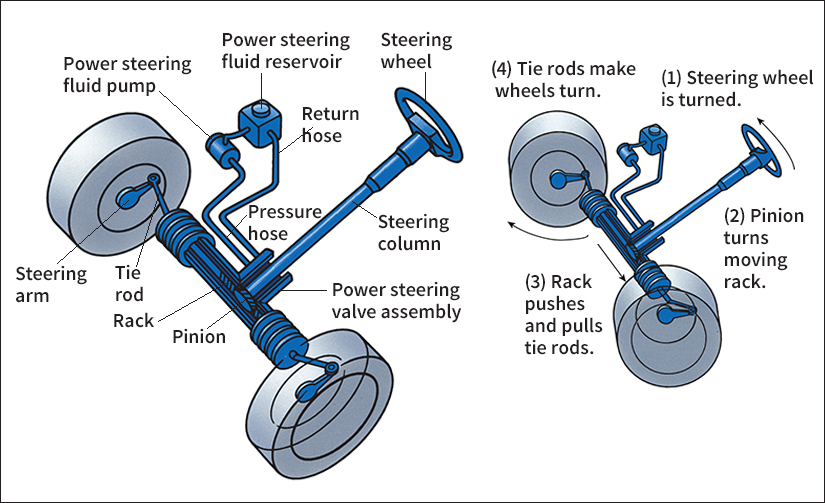
Most cars produced since the late 1980’s use a different system called fuel injection. The system times and delivers a precise amount of fuel to the engine’s cylinders. A pump—either in the fuel tank or on the engine—forces pressurized fuel through fuel lines. The fuel lines connect to needlelike injectors in the engine. A single-point system injects fuel from a single injector into a pipe that branches and feeds into the cylinders. But most cars today use multiport or direct injected systems. Such systems have separate injectors for each cylinder. An electric current opens the needlelike valve in the injectors, allowing pressurized fuel to spray out.
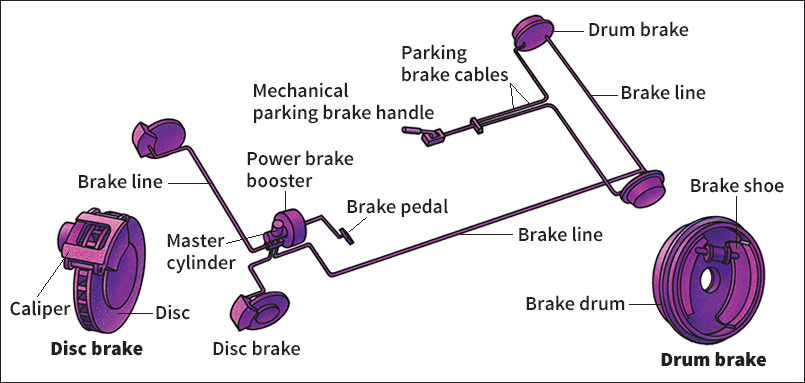
The exhaust system
channels, cleans, and cools the burned waste gases from the engine cycle. It then releases them into the air. In the fourth stage of the engine cycle—the exhaust stroke—these gases are squeezed out of the cylinder through the exhaust valve. The valve leads to a structure called the exhaust manifold. In some cars, the manifold is a single pipe. In others, it is a set of pipes.
The exhaust manifold channels the gases into a cleansing device called a catalytic converter. The inside of a catalytic converter is somewhat like the inside of a honeycomb. It is divided into many cells. The cells are coated with certain rare metals, including platinum, palladium, and rhodium. As the waste gases flow over the metals, chemical processes break the pollutants down into safer substances.
The gases that leave the catalytic converter, while cleaned, are still much hotter than the outside air. If released into the air, the hot gases would expand rapidly and create loud noise. A final device in the exhaust system, the muffler, cools the gases before releasing them. The muffler consists of a series of tubes pierced with holes. It slows down the gases, cooling them, before letting them out of the car.
The cooling system
keeps the engine from overheating. The engine cycle involves repeated explosions in the cylinders. It results in high temperatures that, without cooling, could damage the engine. The cooling system works by channeling the engine heat elsewhere.
The cooling system pumps a coolant—a mixture of about half water and half antifreeze—around the cylinders. The areas around the cylinders that hold coolant are called water jackets. The coolant absorbs heat from the cylinders as it flows through the water jackets.
The hot coolant then passes through copper or aluminum tubes in the radiator. Fins on the radiator—also made of copper or aluminum—absorb heat from the coolant. The coolant, having given its heat to the fins, returns to the engine, where the process starts over.
The now-hot fins, in turn, are cooled by air that flows around them. The air is drawn by the motion of the car and, at slower speeds, the motion of a fan. The heated air can be used to heat the car’s interior in cold weather. Otherwise, it is pumped out of the car.
The lubrication system
keeps the parts of the engine moving smoothly. It delivers oil that coats the moving parts of the engine with a thin film. The film helps the parts slide over each other. It reduces friction, which can slow or damage the engine. The oil also helps cool the engine.
Oil is stored in a pan under the engine. A pump circulates oil from the pan, through a filter, through lines, and finally to the engine. The filter removes impurities from the oil, protecting the engine.
Powering electric and hybrid cars
Electric cars use an electric motor powered by a rechargeable battery to turn the wheels. Hybrid vehicles have both an electric motor and an internal-combustion engine. They can run either device or both at the same time. In hybrid and electric cars, the battery can be recharged when the car brakes. Hybrid vehicles thus use much less fuel than cars with only an internal-combustion engine. Electric cars use no fuel at all in their power system.

Electric automobiles have existed since the late 1800’s. But early electric cars were slower than cars with internal-combustion engines. In addition, the cars could at first only be used in the few large cities that had access to electric power. Electric cars thus fell out of favor.
Today, improvements in battery technology and wide access to electric power make electric cars more practical. Hybrid cars, which combine an electric motor and an internal-combustion engine, offer consumers the strengths of both types of vehicles.
Electric motors
are devices that convert electric power to mechanical motion. This conversion is possible because electricity and magnetism, in physics, are closely related. When an electric current flows through a metal conductor, it creates a magnetic field around that conductor. Like a bar magnet, this field has a north and south pole. When a magnet’s north pole is brought near another magnet’s south pole, they attract each other. But when two north poles or two south poles are brought close together, they repel (push away) each other.
In a car’s electric motor, the conductor sits inside a second magnetized device, called the stator. The conductor can turn, but the stator is fixed in place. When current flows through the conductor and magnetizes it, the stator’s magnet attracts and repels the conductor. These interactions cause the conductor to spin around.
The spinning conductor is connected to a shaft called the rotor. The rotor, in turn, connects to the car’s transmission. The transmission transfers the rotor’s spinning motion to the wheels.
Hybrid power systems
come in two main types, series and parallel. In a series hybrid vehicle, the electric motor is the only device that is connected to the transmission. Its internal-combustion engine powers a second electric motor. This second motor, in turn, acts as a generator. It is used only to recharge the first motor’s battery pack. Energy flows from the engine to the secondary motor, to the battery, to the primary motor, and finally to the car’s transmission.
In a parallel design, both the internal-combustion engine and the electric motor are connected to the car’s transmission. Through the use of a computer and gear clutches, the car can use either the engine or the motor—or both in combination—to move the wheels.
Batteries and braking.
In electric and hybrid cars, current runs from the battery to the electric motor to power the car. However, the nature of electric motors allows current to run in the opposite direction as well, recharging the battery. Electric and hybrid cars take advantage of this fact in a process called regenerative braking. The brakes in most cars slow a spinning wheel by applying friction. The friction converts much of the wheels energy into heat, slowing its spin. In regenerative braking, the wheel’s spin is channeled backward through the car’s drive system and transmission and into the electric motor. There, the kinetic energy spins the magnetized conductor around. This motion generates an electric current that flows back into the battery, recharging it.
Regenerative braking can greatly increase the distance an electric car can travel before being plugged into a power source to recharge. In hybrid cars, it increases the distance the car can travel before refueling. However, hybrid and electric vehicles still use standard brakes to stop quickly at higher speeds.
Driving an automobile
To drive an automobile, a person must understand how the machine works and how to control it. A person must also know and obey the rules of the road. Most countries require drivers to earn licenses. To earn a license, a person must pass a series of tests. Careless or unlawful drivers may lose their licenses.
In addition, many states and countries require drivers to purchase car insurance. The insurance covers potential damage to a driver’s car, as well as potential damage to other vehicles, property, and people. Drivers who are young or have records of accidents or traffic violations usually must pay more for car insurance.
Operating a car
normally requires the use of both hands and at least one foot. Most cars are started by turning a key, which cranks the engine to life. Some hybrid and electric vehicles are started by pushing a power button instead of turning a key.
Once the car is started, the driver presses down the brake pedal and shifts the transmission from park to either reverse or drive to move the car. Most cars, once in reverse or drive, will begin moving as soon as the driver stops pressing the brake—without having to press the gas pedal. The gas pedal is used to accelerate the car.
Levers near the steering wheel enable drivers to control various features on their cars. One lever operates the car’s turn signals, blinking lights on the car’s exterior. Drivers use turn signals to let other drivers know when they intend to turn left or right. They also use them to signal when changing lanes. Other levers control windshield wipers, headlights, and cruise control.
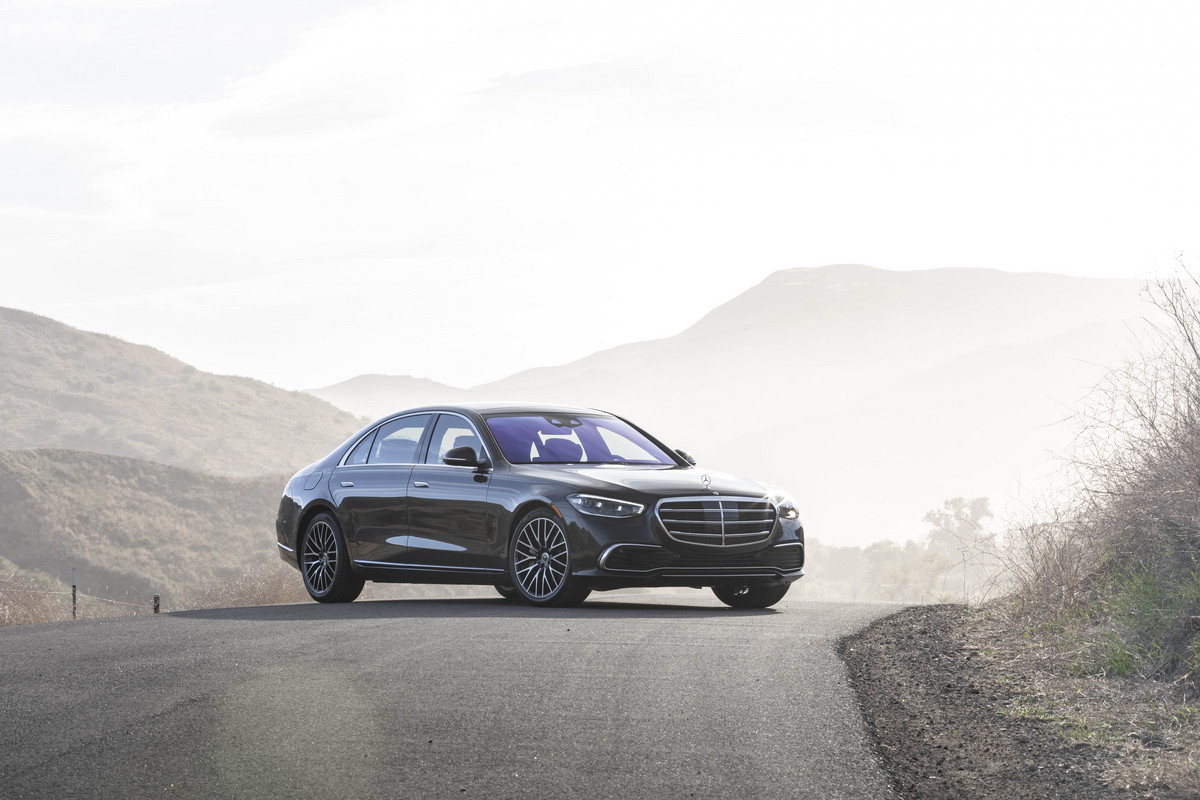
Drivers use mirrors to see behind and to the sides of their cars. The rearview mirror above the windshield provides a view through the car’s back window. Using the rearview and side mirrors, drivers can get a good view around their vehicles. But all vehicles have blind spots—that is, places to the side and rear of the vehicle that are not visible in any of the mirrors. Some types of automobiles, such as trucks, have trailers or other objects blocking the view out their back windows. They thus have no rearview mirrors. Drivers of such vehicles must use only their side mirrors to navigate and so have a much larger blind spot. It is important to note the blind spots of other drivers on the road to avoid surprising them and, possibly, colliding with them.
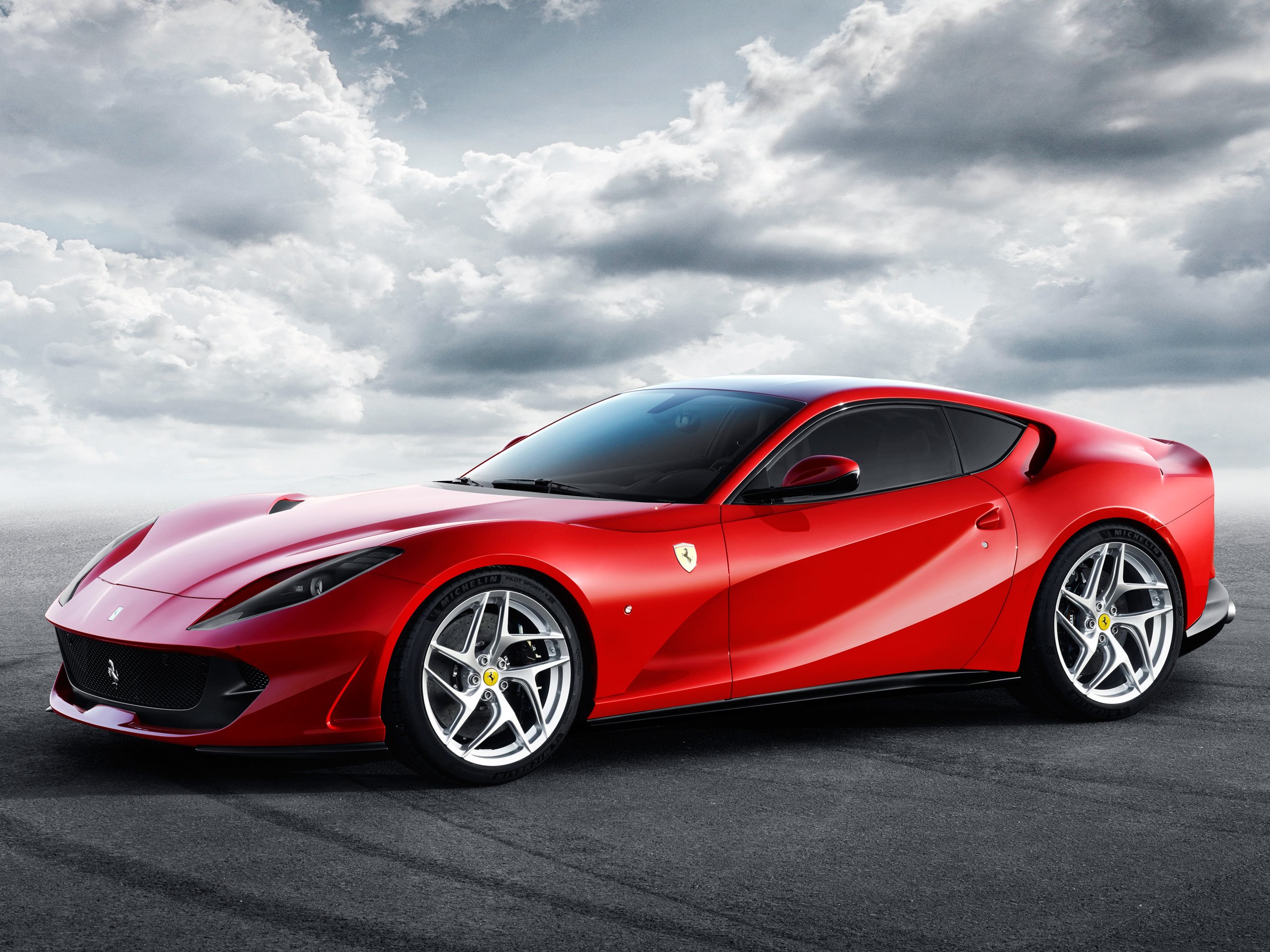
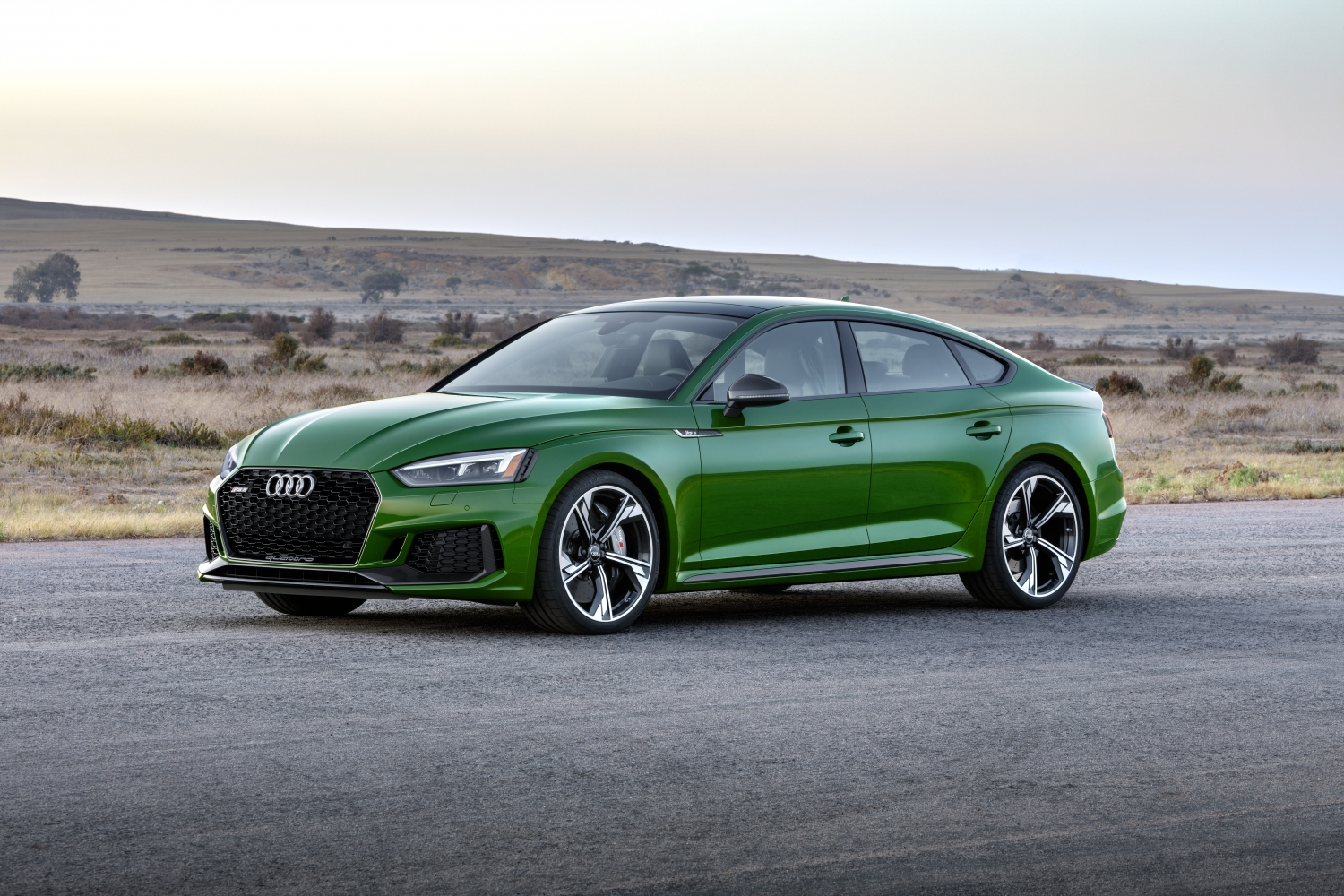
Rules of the road
help to coordinate traffic and prevent accidents. Many rules are enforced by law. Signs and traffic lights tell drivers when to stop the car or yield to cross traffic or pedestrians. Signs also show speed limits. Police officers use radar guns to measure the speeds of vehicles and can pull over drivers who exceed the limit.
In addition to following signs and traffic rules, drivers have other responsibilities. Drivers must remain alert to avoid accidents—especially while turning, speeding up, changing lanes, or performing other maneuvers. It is illegal to drive under the influence of alcohol or other drugs. Such substances slow or change a person’s reactions, which can lead to deadly accidents. Some cities limit or ban such dangerous distractions as cell phone use and text-messaging while driving. In some places, it is illegal to ride in a car without a seat belt. Drivers also must see that their cars are properly maintained. Poorly functioning cars can be dangerous on the road.
Defensive driving
means anticipating danger to avoid accidents. A defensive driver stays alert to all possibilities, such as other vehicles slowing down, entering the roadway, or stopping suddenly. A defensive driver adjusts the car’s speed and position to suit visibility, the road, and traffic conditions. He or she slows down before entering a curve and yields the right of way. A defensive driver also signals well in advance before turning or changing lanes.
Building an automobile
To maintain interest and sales, most automakers bring out new car models every year. But most new models are updates on existing models. New model designs may correct problems in earlier models, add new features, or give the car a fresh look to attract new buyers. High costs prevent automakers from making major changes or introducing entirely new cars every year.
Developing a new vehicle, or even merely updating one, is a complex task. It requires many people, technologies, and parts. The whole process, from idea to finished car, may take from two to four years. Automakers therefore try to predict several years in advance what kind of cars buyers will want.
Planning the car.
The first step in developing a new car is typically market research. Manufacturers survey car owners and people in the age or income groups they would like to target as potential buyers. Car designers plan an entire car’s design based on such people’s likes and dislikes, from the interior fabrics to the exterior colors. They use computer-aided design (CAD) to create hundreds of drawings and models. They can then quickly test, modify, and re-create the models.

Traditionally, modelers used clay to turn the computer drawings into a concept car—a full-sized model that resembled a real car. Other specialists created interior models of the car’s seats and instrument panel. Next, workers built a fiberglass body based on the clay concept car and interior models. The fiberglass model was given real tires, glass windows, doors, and interior and exterior decorations to look as much like the final product as possible. After further reviews, development on the new car began in full force.
Today, the auto industry uses fewer models because computers can accurately simulate many of a car’s physical properties. For example, car models were once exposed to a wind tunnel to give a sense of how air flowed around the vehicle. Computer simulations today can provide the same information quicker and cheaper.
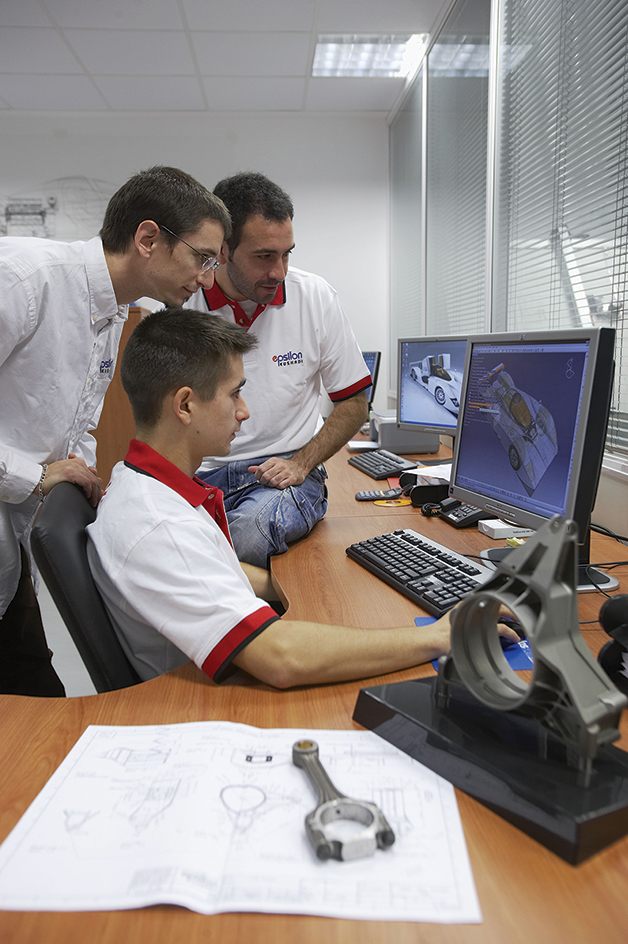
Engineering the parts.
After the car design is settled, a team of engineers plans every part of the car. Some parts, such as the engine and transmission, may be reused from previous models. But many other parts are newly created.
Engineers rely on computer programs to design parts and combine them into the working systems that make up the car. Computer programs also help make dies—the precision tools that shape metals and other materials into parts.
Testing the car.
As the car’s parts are engineered, manufacturers assemble prototypes (working samples) of the vehicle to test how it performs. The prototypes are often run for 24 hours a day, covering 100,000 miles (160,000 kilometers) or more, to test their endurance and emission levels. Emission levels are the amounts of pollutants, such as carbon monoxide and hydrocarbons, released in the car’s exhaust. Carmakers also crash prototypes into walls to test their safety. Computers can model how well a car will protect its occupants in a collision. But government safety standards require actual crash tests.
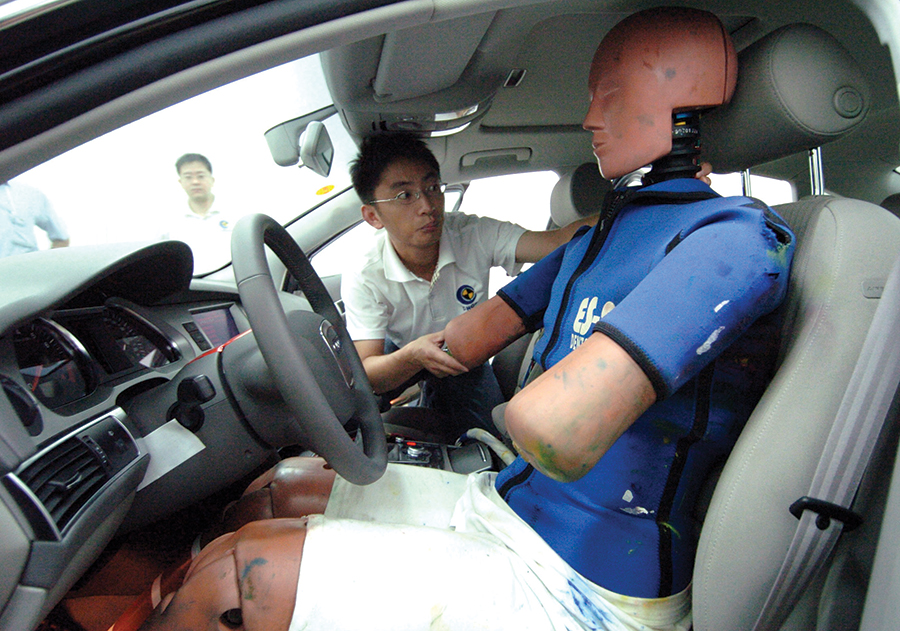
Prototypes are typically much more expensive to produce than finished cars, costing hundreds of thousands of dollars each. They are built without the cost savings that come from manufacturing many cars at once on an assembly line. If the prototypes fail the tests, they must be redesigned and remade until they pass. But assembling the prototypes can give manufacturers insight into production processes. For example, the process of assembly may reveal design problems that manufacturers can then correct to make assembly of the final car more efficient.
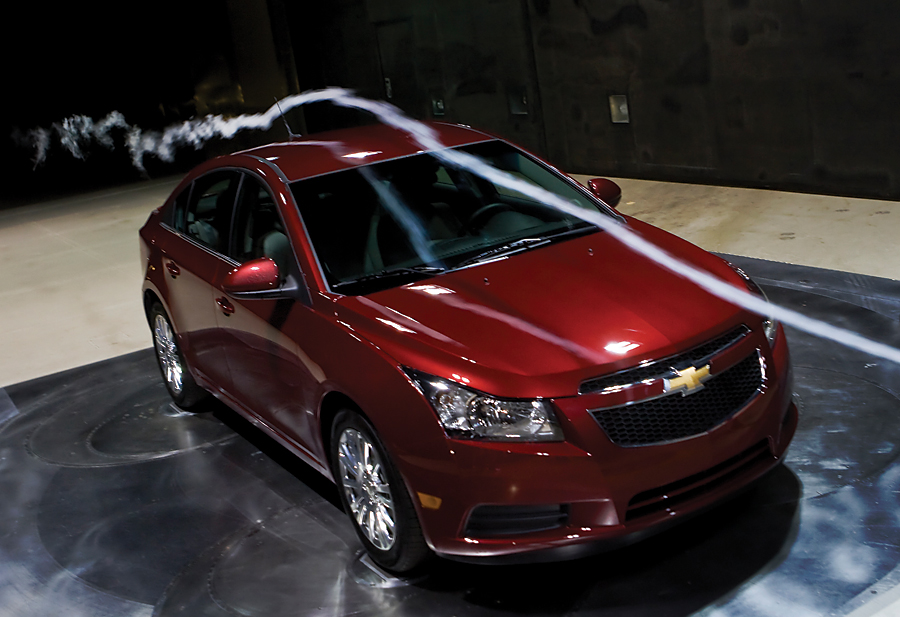
Buying materials.
Based on specifications developed by engineers, automakers purchase the raw materials and parts to make the finished car. The suppliers of such parts sometimes make them from scratch based on a blueprint supplied by the manufacturer. The supplier may be another division of the manufacturer’s company. But much automotive manufacturing relies on outside suppliers. Outside and inside suppliers bid (compete) for work.
Manufacturing
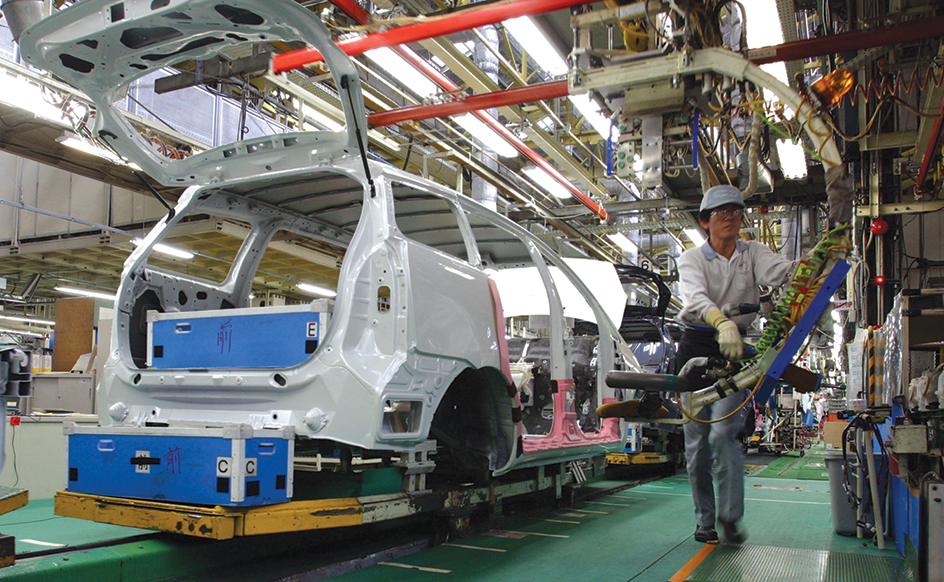
Computers also control many of the power-driven tools called machine tools that create a car’s parts. In a process called metal stamping, pressing machines shape metal into forms determined by engineering dies. Small presses stamp out such parts as brackets and handles. Huge presses create a car’s trunk lids, floor, roof, fenders, doors, and hood. Many parts of car bodies are made from lightweight fiberglass, plastics, or composite materials instead of metal. Composite materials consist of two or more substances. Most such parts are molded instead of stamped.
Another process, casting, involves pouring molten metal into a mold. The metal solidifies in the shape of the required part. The engine block is the main car part made by casting. Blocks are cast from iron, iron alloys (mixtures of iron and other metals), or aluminum.
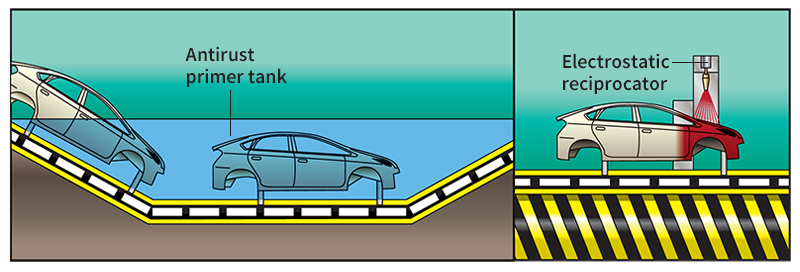
Forging shapes steel or iron into the desired form by hammering. Crankshafts and certain pieces of the suspension system are forged. Machining involves using various tools to cut, grind, and shape precision parts, such as those used in engines and transmissions. Other processes are used to shape a car’s plastic equipment.
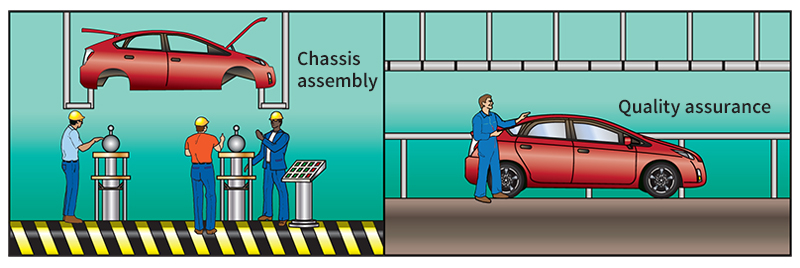

After the parts have been manufactured, workers put together a finished car on an assembly line. They weld and bolt the exterior parts together, install the engine, and attach the interior parts. Final assembly also includes painting the car and adding options. Options are special features—for example back seat DVD players or seat warmers—that can vary among cars in the same model. An assembly line may turn out up to 75 cars per hour. Robots perform many tasks on an assembly line, such as welding and painting. Quality inspectors examine the work with cameras and lasers that precisely measure how the parts fit together.
The auto industry
Automobiles cost a great deal to produce, and most manufacturers operate out of wealthy countries. In many countries, automobiles make a major contribution to the economy. The auto industry is closely tied to a number of other important industries that together provide tens of millions of jobs worldwide.
Where cars are made.
The top four countries for automobile production are China, Germany, India, and Japan. Other major producers include Brazil, the Czech Republic, France, Indonesia, Russia, Slovakia South Korea, Spain, the United Kingdom, and the United States. Some large corporations own or control several automobile companies, often in more than one country. Many developing nations assemble cars and trucks for automakers based in other countries. Many other countries make the parts that are used in automobiles.
Each country’s auto industry developed around the unique conditions of its local economy, society, and market. For example, Japan’s auto producers have tended to make small cars designed for fuel efficiency rather than power. Such cars appeal to consumers in Japan, where fuel is expensive and many streets are too narrow or crowded for big cars.
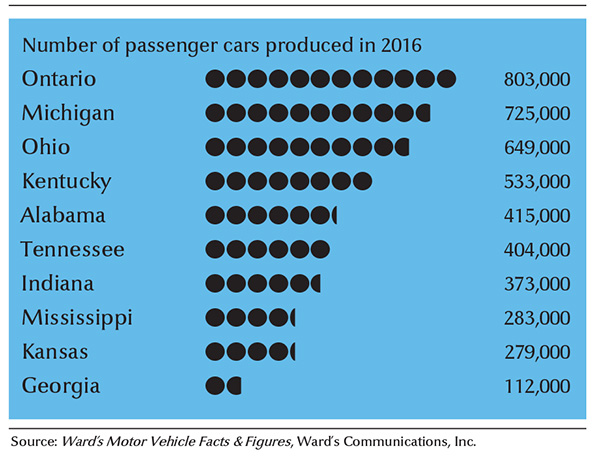
A number of German companies have targeted the luxury and sports car market. Other German companies offer low-cost passenger cars. German companies also produce about half of the diesel automobiles in the European Union. Most diesel passenger cars in the United States are imported from Germany.
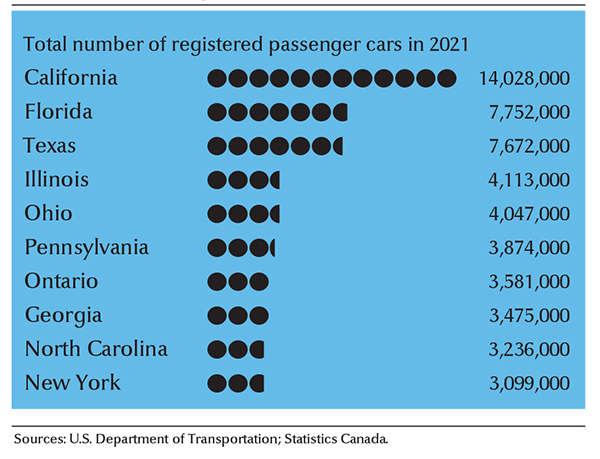
Canada, Japan, the United States, and the countries of western Europe long had most of the world’s automobiles. But in the early 2000’s, the automobile markets in China and India grew rapidly. In 2009, for the first time, more cars were sold in China than in the United States. China was also the fastest growing auto manufacturer in the world. The country has limited roads and depends on imported oil. Thus, Chinese manufacturers produce many smaller, fuel-efficient vehicles. China’s industry also emphasizes hybrid and electric vehicles to take advantage of the electric power produced by the country’s large coal supply.
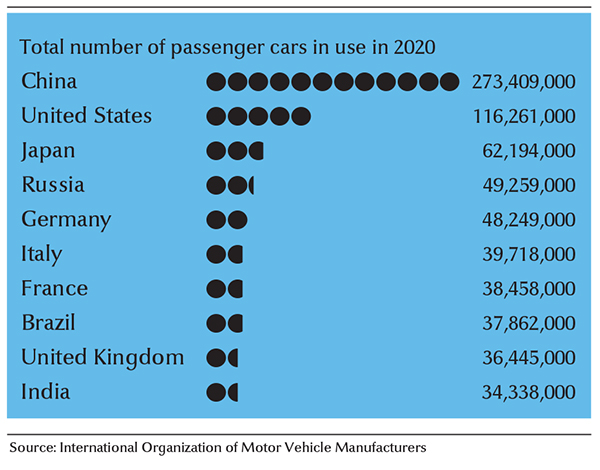
Economic impact.
Automobile manufacture depends on many other industries for various parts. These industries include the computer, glass, electronics, petroleum, plastics, rubber, steel, and textile industries. Furthermore, many people have jobs in car salesrooms, repair shops, and finance offices. Other people work in advertising developing car commercials. Small companies that make car parts employ hundreds of thousands of workers. In the United States, for example, about 4 million people are employed in jobs tied to the automobile industry.
For much of society, the widespread influence of the auto industry has transformed the nature of work. During the 1900’s, millions of people left farms to live in cities and work in factories tied to carmaking. In the United States, such factories provided jobs to minority groups and recent immigrants. Work on assembly lines and other factory jobs required few specialized skills. Thus, the work of skilled artisans and craftspeople gave way to mechanized, unskilled labor. The industry also needed a large number of new managers and engineers to design and oversee car production and make business decisions.
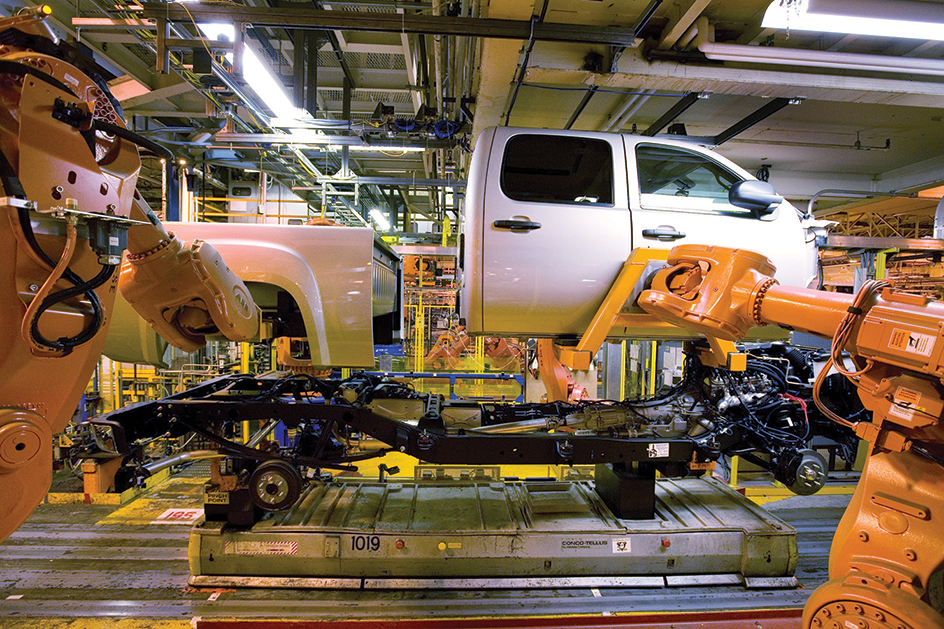
Before the automobile became part of life in industrialized countries, average people owned few possessions and had little money. Many of them were enriched by the jobs provided by the auto industry and by the facilities and services that support car owners. Wages in the auto industry tended to be higher than hourly pay in service industries. Higher incomes helped create a consumer culture (a way of life that revolves largely around the purchase of goods). Advertising grew in importance as people had more money to spend and cars enabled them to drive to a wider variety of stores.
The health of the auto industry is closely tied with the overall economic health of many countries and that of the entire world. In 2007, a global recession (economic slump) began. In 2008, the auto industry suffered a severe downturn. At the same time, unemployment surged in many countries, deepening the recession.
The U.S. auto industry once consisted of three large corporations known as the “Big Three”—Chrysler Group LLC, General Motors (GM), and Ford Motor Company. But in 2009, two of the companies—Chrysler and GM—went bankrupt during the recession. The two companies reorganized with government assistance. All three companies produce a variety of cars and light trucks under a number of trade names. They have thousands of suppliers, including such large corporations as United States Steel Corporation, General Electric Company, and TRW Automotive.
Automobiles and society
Perhaps no technology has shaped modern society as much as the automobile has. A vast system of roads now connects distant places, communities, and economic markets. The automobile industry generates a huge amount of economic activity around the world. For some people, cars offer a sense of identity and social status. Automobiles have also introduced new dangers from collisions and reckless driving.
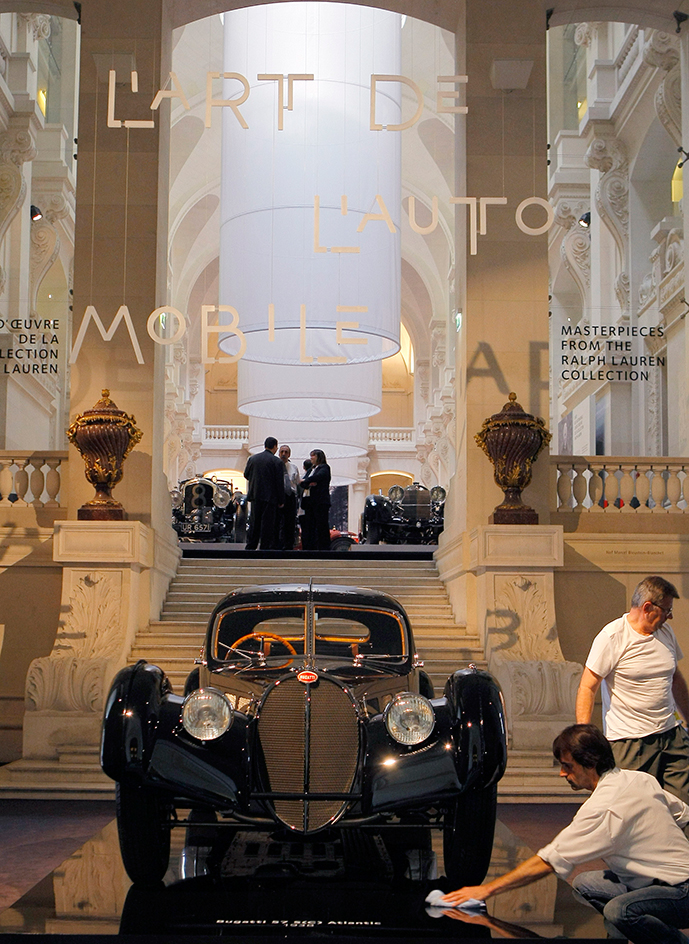
Demand for services and facilities.
As automobiles became more popular, their use required the creation of new infrastructure (essential services and facilities) to support them. Such infrastructure includes paved roads, gas stations, repair shops, and everything else that enables cars to function smoothly.
Roads.
Before the automobile, most roads were little more than dirt paths. They were dusty in dry weather and rutted and muddy in winter. Rivers and coastal waters served as the main routes for the flow of people and goods. Today in developed countries, cars and trucks carry most people and goods along highway systems that crisscross the land.
Beginning in the 1920’s, national governments became involved in building better roads to connect major cities. Funding for such roads originally came from taxes on gasoline. Some of the earliest roads for automobiles were undivided highways that could be dangerous. After about 1950, more effort went into constructing divided highways to increase safety. Such highways have a strip of land called a median strip to separate lanes of traffic going in opposite directions. Highway designers also built many freeways and expressways. These roads achieved a safer, smoother traffic flow by limiting where vehicles can enter and leave.
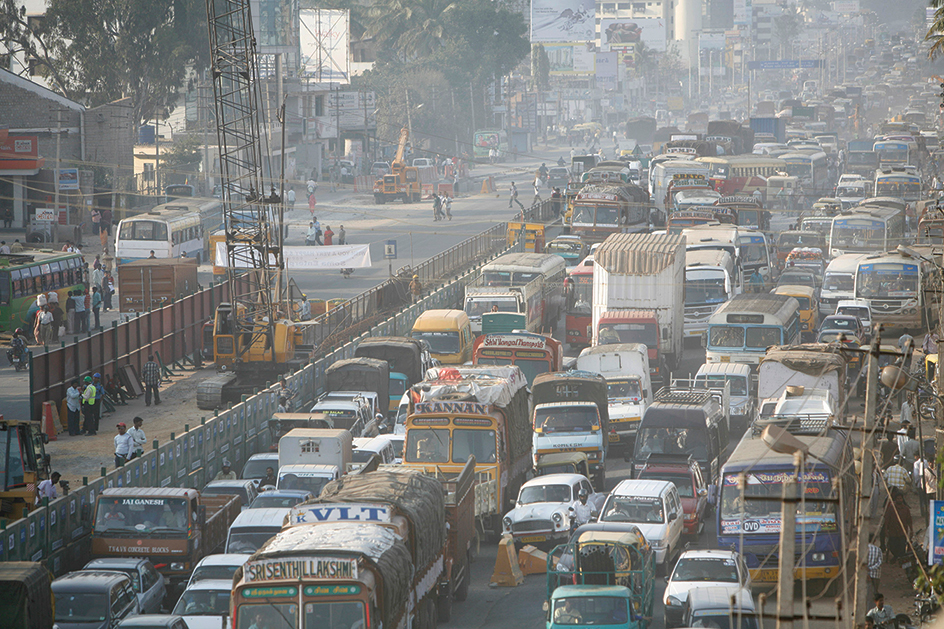
Some highways became national landmarks. In the United States, Route 66—also known as the “Mother Road”—connects the Midwest to southern California. Other famous highway systems include Italy’s Autostrade and Germany’s Autobahnen. In India and China, new roads support the explosive growth of automobile ownership.
Fast highways offer convenience for traveling citizens. They also serve as critical routes for national defense and evacuation planning.
In the United States especially, expressways link cities and the suburbs surrounding them. But in some cases, such links have contributed to the decline of inner cities by allowing people and businesses to move to the suburbs. Some critics claim that city-based expressways are unsightly. In Europe, many highways stop short of entering cities.
Other infrastructure.
Alongside the world’s highways lie gas stations, truck stops, restaurants, repair shops, camps, and motels. Such establishments sprang up to service the growing numbers of drivers and cars.
Gasoline was only available to drivers at general stores at first. But starting in 1905, gas stations became a roadside fixture. The architecture of gas stations evolved over the 1900’s. Early gas stations looked like small homes. Modern gas stations feature wide canopies, self-service pumps, and convenience stores.
Early drivers traveling long distances were forced to camp on the side of the road and bring their own food. As automobile touring became more popular, the demand grew for places to sleep along the road. Such places included tourist cabins and, later, motels.
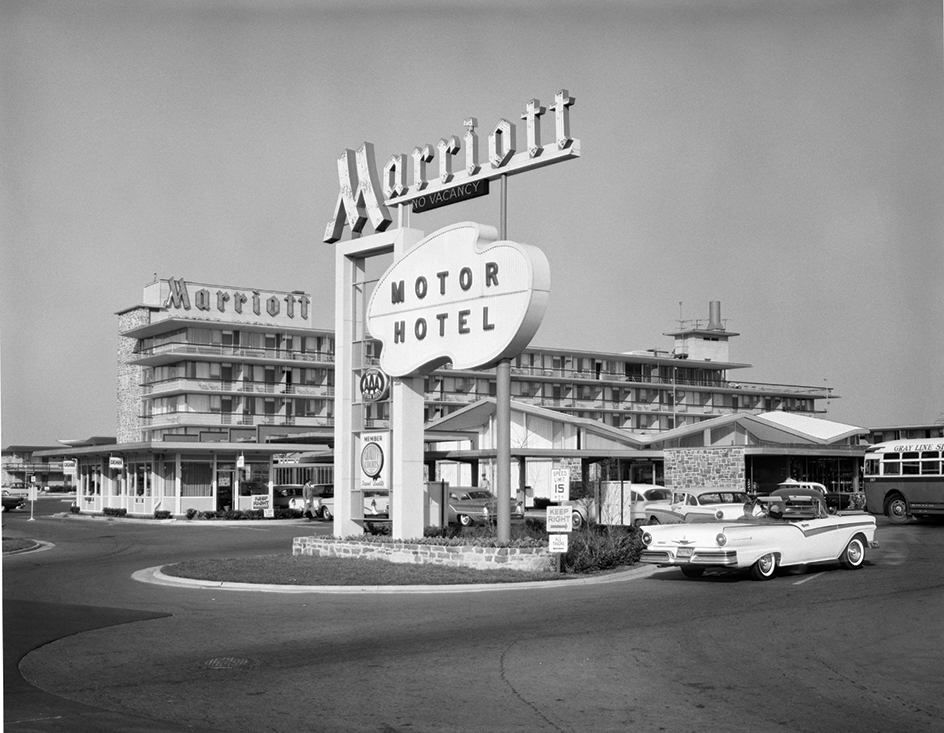
Restaurants also developed along the highways, including early “greasy spoon” diners. In the 1940’s, roadside chain restaurants, such as Howard Johnson’s, became popular. These, in turn, lost customers to fast-food restaurants, such as McDonald’s. Many such restaurants are designed around the automobile, offering drive-through food services.
A type of infrastructure called the power grid channels electric power from power plants to homes and other buildings. Electric cars, in particular, rely on the power grid, to recharge after use. Power plants for cities typically produce extra electric power that is not used—power that electric cars can store in their batteries. Electric cars may become even more convenient to use when widespread improvements to power grids offer drivers more places to “plug in” their cars.
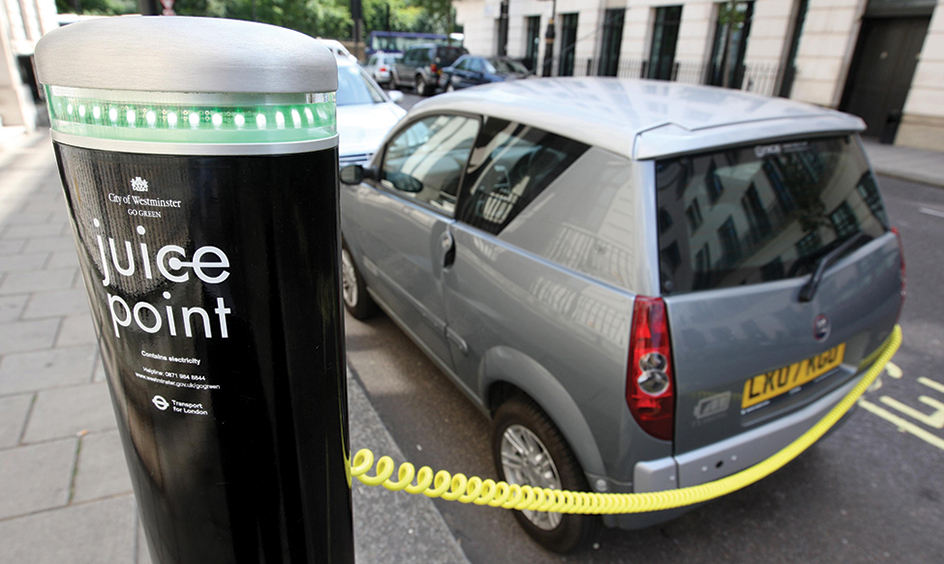
Demand for petroleum.
The rise and dominance of the petroleum industry is closely linked to automobiles. Petroleum was once used mainly as kerosene to light lamps. But as gasoline derived from petroleum became critical to the use of automobiles, petroleum suppliers became big international businesses.
Earth has only a limited supply of petroleum and other fossil fuels. As more and more is used, what remains will become increasingly expensive. Petroleum prices rise and fall according to demand for petroleum and the supply available to meet that demand. In general, an increase in demand causes prices to rise. An increase in supply can cause prices to fall. In the 1920’s and the 1970’s, “scares” about running out of petroleum drove up the price of gasoline. In the long term, as consumers continue to use up the world’s fossil fuels, lower supplies will lead to even higher gas prices. High gas prices can deeply affect the design of cars, driving behavior, and car purchasing decisions.
The countries that drive the most cars and so consume the most petroleum are among the world’s wealthiest. Petroleum-producing nations tend to be, in contrast, poorer. This inequality can create resentment and mistrust between consuming and producing nations.
As with any valuable resource, petroleum can also create political conflict. Countries that depend on imported oil have struggled to control petroleum-producing areas. Some historians have argued that the desire for petroleum contributed to the outbreak of many modern wars. Many people also worry that the need to secure a steady supply of petroleum too strongly influences the foreign policy of car-owning, petroleum-consuming countries.
Safety problems.
Every year, about 1 1/4 million people die in car accidents around the world. In the United States, accidents occur almost daily in every area of the country. The scene of such an accident is generally cleaned up and has disappeared within hours. Occasionally crosses or flowers mark the site of a fatal crash.
Despite the many deaths from automobile accidents, consumers and the industry paid little attention to automobile safety until the 1950’s. Before that time, the typical American car had dashboards with numerous hard knobs, brakes and tires of poor quality, and windshield glass that shattered easily. Cars also lacked seat belts. Their steering wheel columns remained rigid—and thus, dangerous—in a crash. Such features endured because of manufacturer neglect, consumer preferences, and a lack of government regulation. Auto industry representatives claimed that drivers’ behavior, and not automobile designs, were to blame for accidents and injuries.
During the 1950’s and 1960’s, public opinion changed. Governments around the world began heavily to regulate auto safety. One major reason for the increased emphasis on safety was a new awareness of the “second crash”—that is, the collision between passengers’ bodies and the car’s interior, after the car crash. This awareness led to the development of crumple zones in cars. A crumple zone is part of an automobile body, usually in the front, designed to collapse and absorb the impact of a crash. Other safety features were introduced starting in the 1960’s, including lap and shoulder belts, padded dashboards, collapsible steering wheel columns, antilock braking systems, and airbags. Such features are now standard on almost all passenger cars.
Despite improvements, safety problems remain. Engineers design most cars to have a low center of gravity—that is, to keep most of the car’s weight low. A low center of gravity makes a vehicle hug the road and handle better. Sport utility vehicles, however, have high centers of gravity because of their greater height, boxy design, and high ground clearance. A high center of gravity makes them vulnerable to rolling over in a crash.
In addition, reckless driving remains a constant source of danger. Drivers under the influence of alcohol or other drugs cause accidents that injure or kill hundreds of thousands of people each year. New technologies, especially text messaging on mobile phones, provide a dangerous source of distraction for many drivers.
Automobiles and the environment
During the early 1900’s, a number of experts warned that the widespread use of internal-combustion engines could damage the environment and deplete the world’s limited supply of fossil fuels. But cars with internal-combustion engines soon became overwhelmingly popular, and most people ignored such concerns. As a result, much of the modern world’s economy and infrastructure has come to depend on automobiles powered by fossil fuels. Thus, reducing the environmental impact of cars and their use of fossil fuels requires reshaping and rethinking important and established parts of our society—a serious challenge.
Damage to natural habitats.
Roadways and other automobile infrastructure have altered the landscape in many places. Roads and highways cut through forests and other natural habitats. Wherever there are roads, fast-moving cars endanger deer and other animals that try to cross the road. Runoff from paved highways and parking lots may contain oil and other dangerous chemicals from cars. These pollutants may seep into the ground or enter rivers and streams, harming plants and animals. Many car parts, such as tires, batteries, and used motor oil, are not biodegradable—that is, they are not broken down by nature after they are thrown away. Noise and light from cars can also disrupt the natural cycles of many living things.
Air pollution.
The burning of gasoline and diesel fuel generates emissions—including exhaust gases, other chemicals, and particles—that pollute the air. Many automobile emissions, such as carbon monoxide and sulfur dioxide, are poisonous to plants, animals, and people. Nitrogen oxide, another pollutant in automobile exhaust, reacts with chemicals called hydrocarbons and sunlight to form a substance called ozone. Near Earth’s surface, ozone helps create a thick yellow haze called smog.
Automobile emissions first received significant attention in Los Angeles during the 1950’s. The number of cars in the region had more than doubled in a little over a decade, greatly increasing the amount of car exhaust. Much of Los Angeles lies in the San Fernando Valley, a natural basin that traps large amounts of exhaust fumes. The increased emissions, combined with the unique landscape, produced smog that often blanketed the city. Eye irritation and damage to vegetation were commonplace.
Automobile manufacturers did little to reduce emissions until the 1960’s, when the federal government intervened. Car manufacturers gradually added equipment that cleaned car emissions, such as catalytic converters. California, in particular, set strict standards for vehicle emissions. In 1989, the state adopted a long-term plan to combat air pollution in Los Angeles and the surrounding area. Los Angeles still ranks among the U.S. cities with the worst air pollution, but its air quality has begun to improve.
Global warming.
Many scientists consider automobile use to be a major factor in global climate change. Earth’s average surface temperature has risen since the mid-1800’s in a trend called global warming. Global warming results chiefly from an increase in greenhouse gases in the atmosphere. These gases trap heat from the sun, acting much like the glass roof and walls of a greenhouse. Carbon dioxide, one of the main greenhouse gases, makes up the largest portion of the waste gases produced by automobiles. Scientists believe global warming, if unchecked, will greatly harm both the natural environment and human society.
History
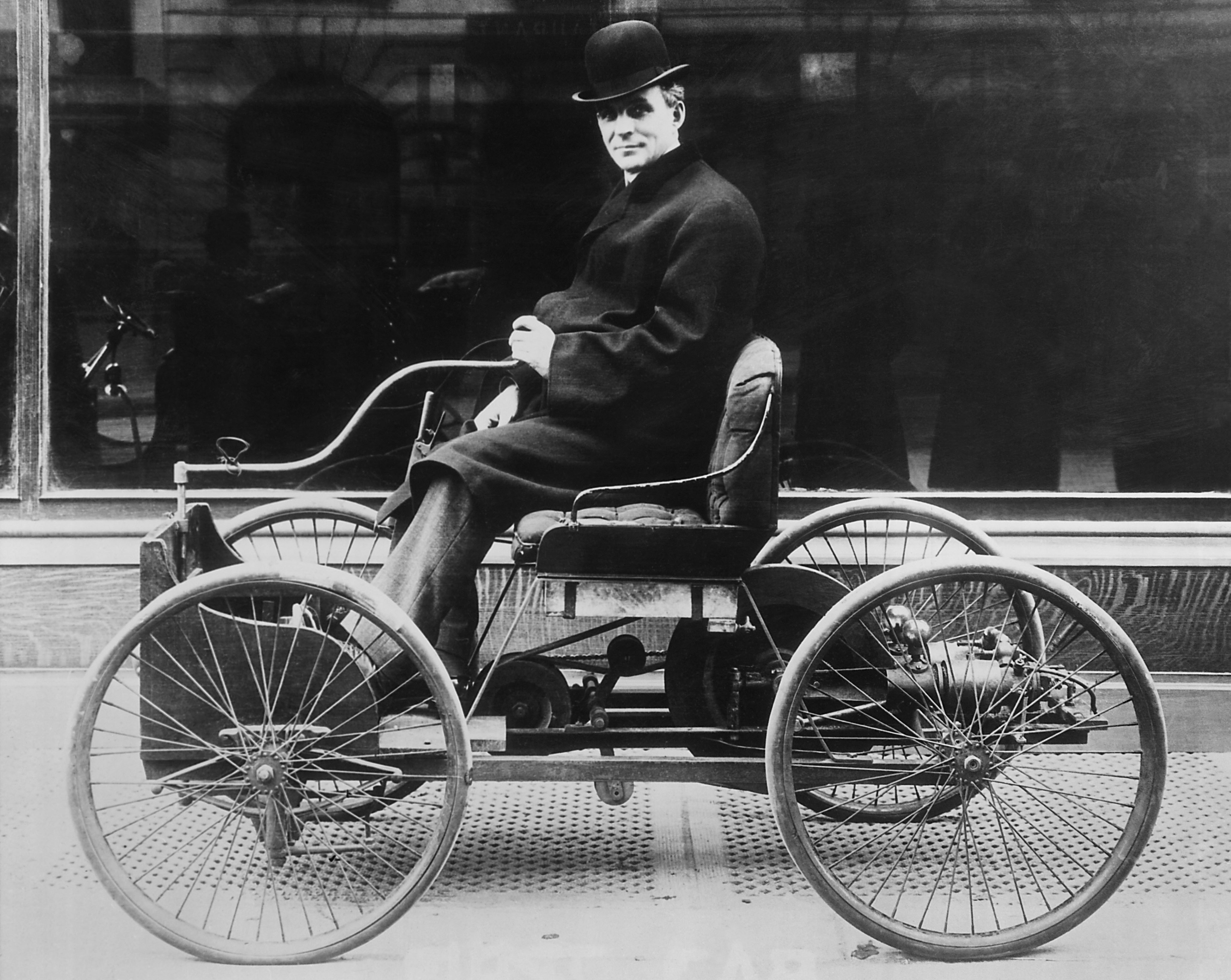
The origin of the automobile can be traced to Europe. But it first became a major form of transportation in the United States. Most European cars were built by hand. They were expensive, and few people could afford them. In the early 1900’s, Ransom E. Olds, Henry Ford, and other American auto pioneers began mass-producing cars. The demand for affordable cars grew rapidly. Automobiles saw action near the battlefields of two world wars. The auto industry soon spread around the world. As automobiles became a vital part of human society, automakers developed new cars to suit changing consumer tastes and the demands of government regulation.
Early automobiles.
Automobiles first emerged during a period of great social and technological change called the Industrial Revolution, which began in the late 1700’s. Throughout Europe at this time, new machines and factories transformed the way many people worked and lived. Inventors in Europe dreamed of a “horseless carriage.” Steam, used to power many machines at the time, seemed the obvious power source.
The steam car.
In 1769 and 1770, Nicolas-Joseph Cugnot, a French military engineer, built the first self-propelled road vehicles. One of them carried passengers. The other was a three-wheeled steam tractor for hauling heavy guns. In 1801 and 1803, Richard Trevithick of the United Kingdom demonstrated four-wheeled passenger vehicles powered by steam. But he lacked the money to continue his work.
During the 1820’s and 1830’s, the United Kingdom made many attempts to promote and develop steam cars. But such efforts failed in the face of competition from railroad and stagecoach companies. Furthermore, early steam cars were noisy contraptions that damaged roads, filled the air with smoke, and frightened horses. Sometimes, they blew up.
In 1865, the Red Flag Law greatly limited the use of automobiles in the United Kingdom. Under the law, a steam car could go no faster than 4 miles (6 kilometers) per hour in the country and 2 miles (3 kilometers) per hour in town. To warn of its approach, a signalman had to walk ahead of the vehicle, swinging a red flag by day and a red lantern by night. These restrictive measures effectively ended automobile development in the United Kingdom for about 30 years.
In the United States, an inventor named Oliver Evans demonstrated a steam-operated dredge mounted on a boat in 1805. Evans put wheels on the boat and drove the gigantic machine—which weighed about 20 tons (18 metric tons)—through the streets, to the harbor, and into the water. During the 1860’s, another American inventor, Sylvester H. Roper, developed a much smaller steam vehicle that looked more like a present-day automobile. Many other Americans experimented with steam cars during the late 1800’s. The number of U.S. companies that made steam cars grew rapidly. One of the most successful firms was founded by twin brothers, Francis E. and Freelan O. Stanley. They built the famous “Stanley steamer” car.
Steam cars had big disadvantages. At first, it took a long time for the fire to heat the boiler. Inventors eventually solved that problem, but the cars remained heavy and expensive. Over time, manufacturers gradually stopped making steam-powered cars. In 1924, the Stanley brothers’ company—one of the last steam car manufacturers—went bankrupt.
The electric car.
About 1891, William Morrison, an American inventor, built a successful electric car. Electric cars quickly became popular because they were quiet, easy to operate, emission-free, and reliable. In 1900, they accounted for 38 percent of all U.S. car sales.
However, most electric cars could travel no faster than 20 miles (32 kilometers) per hour. The batteries had to be recharged at least every 50 miles (80 kilometers). In addition, they could not be used in rural areas that did not have electric power. By 1905, only a few of the cars sold were electrics.
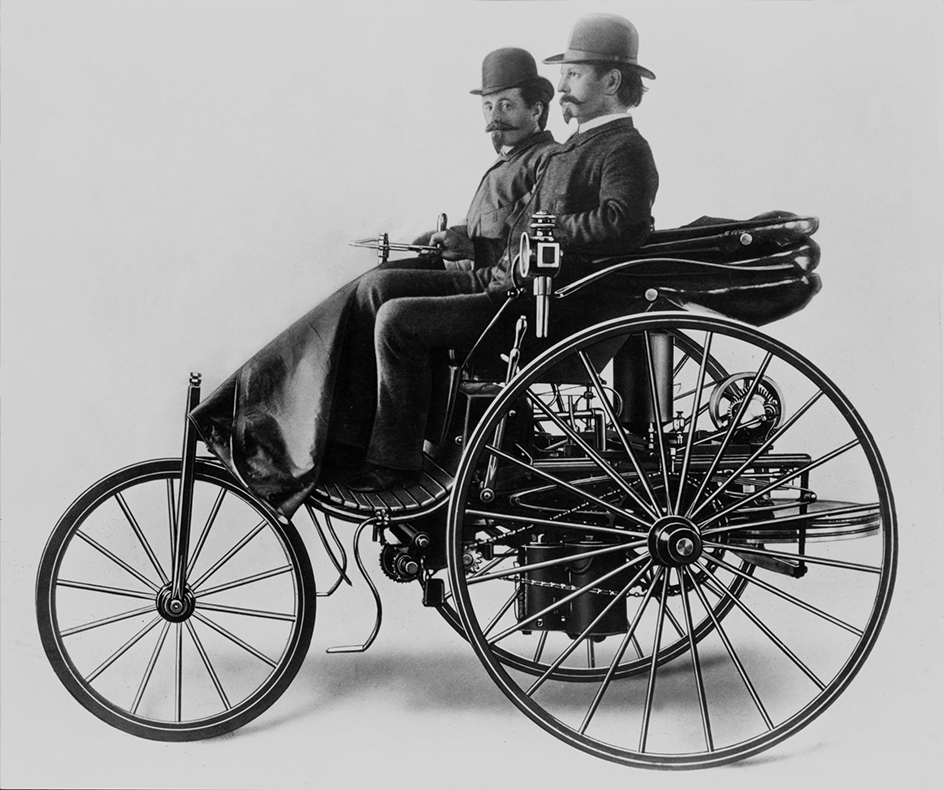
The gasoline car.
Early automobiles owed their designs to the development of other technologies, such as the bicycle. But perhaps the most critical technology was the internal-combustion engine. Étienne Lenoir, a Belgian living in France, is usually credited with inventing the internal-combustion engine. In 1860, he patented a two-stroke engine that used gas obtained from heating coal. A spark generated from a battery and coil ignited the gas. Lenoir’s engine was noisy and inefficient, and it tended to overheat. About 250 of his engines were sold and used to power pumps and machines.
In 1876, Nikolaus August Otto, a German inventor, developed a four-cycle engine. Like modern automobiles, his engine had steps for intake, compression, power, and exhaust. Two German engineers who had once worked for Otto—Gottlieb Daimler and Wilhelm Maybach—designed a “high speed engine” in 1885. Their engine could rotate 600 times per minute. They built several experimental vehicles between 1885 and 1889. Maybach also designed a carburetor for mixing air and gasoline in 1893.
Karl Benz, a German engineer, was the first to link the internal-combustion engine with a wheeled vehicle. In 1885 and 1886, he built a tricycle powered by the engine. In 1889, he exhibited the design at the Exposition Universelle, a world’s fair in Paris. By 1893, he had created an improved four-wheel car with a powerful engine. The vehicle proved reliable, and Benz sold more than 100 of his cars by 1898.
Benz’s invention was soon improved on by Émile Constant Levassor, a French inventor. Levassor took Daimler’s engine and attached it to the front of a vehicle. This car proved itself fast and well-designed in the 1895 Paris-Bordeaux-Paris race.
The birth of the automobile industry.
Until 1900, Europe led the world in automobile development and production. Peugeot, a French firm, started making automobiles in 1890. Another French company, Renault, began producing cars in 1898. Fiat of Italy began operation in 1899. France and Germany became the first large automobile production centers.
The first successful gasoline car in the United States was manufactured by the Duryea brothers. Charles E. and J. Frank Duryea completed their car in 1893. Some American bicycle and carriage manufacturers began producing automobiles around the same time. Many quickly failed. But eventually, after 1900, the center of the auto industry shifted from Europe to the United States. Production of American cars increased from fewer than 5,000 in 1900 to more than 1 1/2 million in 1916.
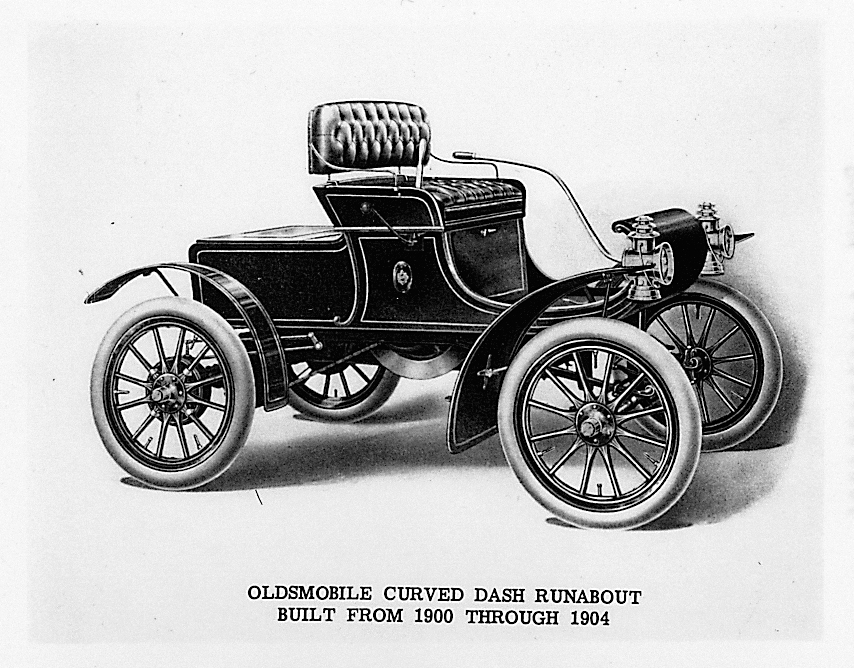
Mass production.
Many historians credit the 1901 Oldsmobile as the first mass-produced car. More than any car before, this automobile was built of parts made by outside suppliers and shipped to the assembly plant. In 1904, Henry M. Leland further developed mass production when he took charge of the Cadillac Automobile Company. Leland began building cars using interchangeable parts. Such parts could be used to assemble or repair any car of the same model. Previously, most parts were made to fit only one particular car.
Henry Ford, an American industrialist, perfected the mass production of cars. Ford believed that there existed a huge market for cheap, reliable automobiles. He understood mass production as a way to achieve both reliability and low cost. In 1908, Ford started production of the Model T. In 1913, he installed a moving assembly line in his car factory. A chain pulled the car’s frame through the plant. Workers on each side assembled the car by adding parts brought to them on conveyor belts. This process resulted in huge savings in production time and costs. 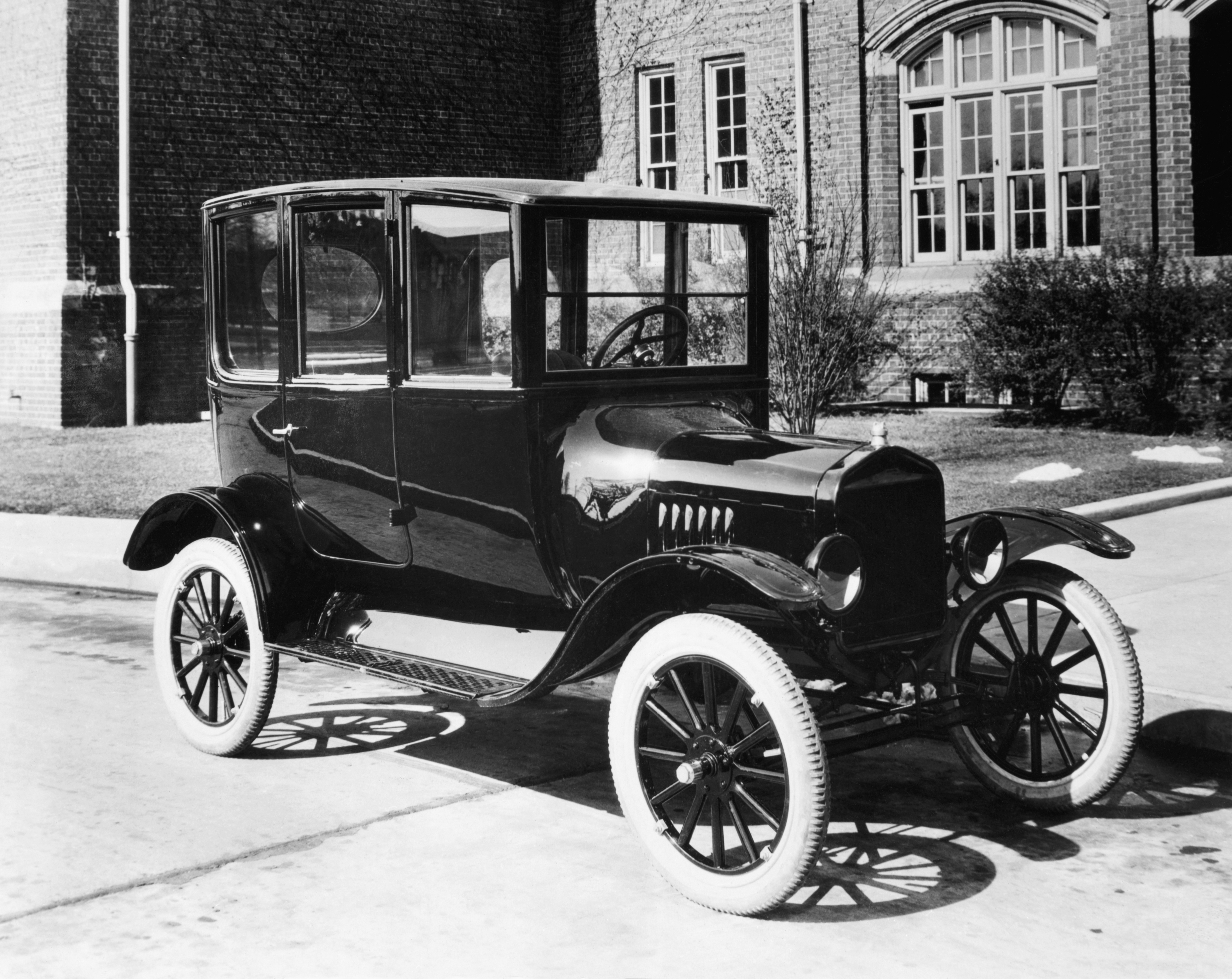
Technological advances.
As the auto industry expanded, various advances made vehicles safer, more comfortable, and easier to operate. One major development was the introduction of the electric self-starter. Charles F. Kettering, an American engineer, invented it in 1911. General Motors installed the first electric starters on its 1912 Cadillacs.
Before the self-starter, people had to insert a crank into the front of the engine and turn it by hand until the engine started. Hand-cranking was difficult and sometimes dangerous. As soon as the engine started, the crank would begin to spin fast and powerfully. As a result, people suffered broken thumbs, broken wrists, and other injuries from hand cranks. The self-starter helped lead to an increasing number of women drivers.
War and depression.
Great changes occurred in the auto industry between the start of World War I (1914-1918) and the end of World War II (1939-1945). There were far fewer manufacturers, but they could produce far more cars. Competition changed from simple mass production to broad marketing programs. The marketing campaigns involved market research, product development, distribution, advertising, and publicity. Most of the pioneers who helped found the auto industry retired or died. Corporations, rather than individuals, began to run most automobile companies.
World War I
was the first conflict that showcased the military value of automobiles. In September 1914, German forces advanced on Paris. The French used Paris taxicabs to rush soldiers to the battlefront. In 1916, the Allies saved Verdun, France, from German capture by carrying fresh troops and supplies to the battle in trucks. Carmakers produced many war goods, including military trucks, tanks, and airplane engines.
During the war, people in the United States continued to purchase cars for personal use. But automobile production fell for the first time in 1918, largely as a result of a shortage of materials. After the war, the industry expanded again.
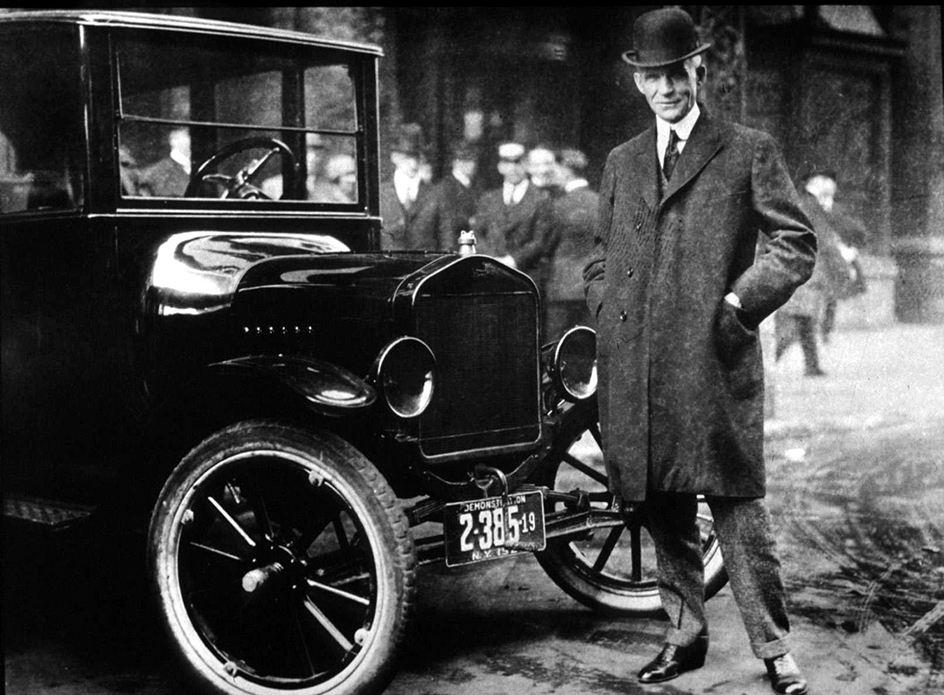
The rise of the Big Three.
An economic slump struck the United States in 1920 and 1921. The sagging economy badly hurt the U.S. auto industry. In response, large auto companies shifted their leadership. In 1923, Alfred P. Sloan became president of General Motors. He developed several ideas that the entire industry came to adopt. Sloan encouraged car sales by changing model styling each year. This tactic is often described as planned obsolescence—that is, the intentional design of products to become outdated soon after purchase.
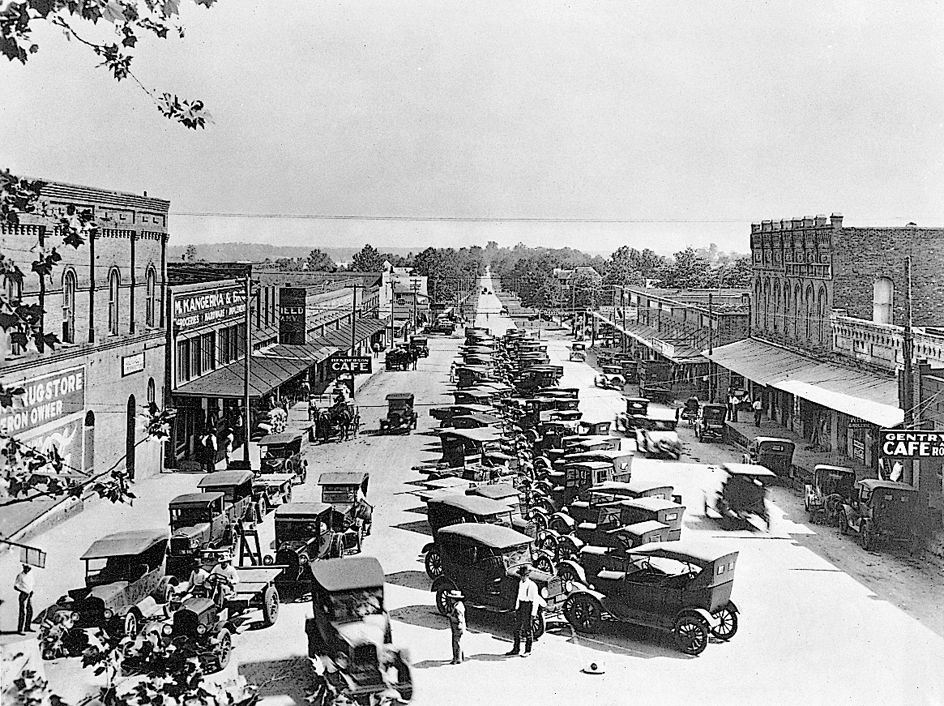
Sloan also set up a system of group management for GM. Each of the company’s car divisions became independent and responsible for its own operations—while the head of the company maintained tight control. This organizational structure proved effective for managing the huge companies that the major automakers eventually became.
Loading the player...Henry Ford makes an affordable automobile
GM and other companies built cars that offered comfort, style, and speed at reasonable prices. Such cars proved tough competition for Ford’s Model T, which ended production in 1927. Ford introduced a new car, the Model A, in the same year. The Model A became the top-selling car in 1928, but it held that distinction for only a short time.
Throughout the 1920’s, the large automakers lowered prices, cutting profits to increase sales. Eventually, only companies that could manufacture and sell large numbers of cars quickly and cheaply could stay in business. The number of U.S. automakers dropped sharply—from 108 in 1923 to only 44 by 1927.
The Great Depression
was a worldwide economic slump that began in October 1929. It hit the auto industry hard. In the United States, production of all vehicles fell 36 percent in 1930, and an additional 29 percent in 1931. By 1932, output had plunged another 44 percent, reaching the lowest volume since the war year of 1918.
Ford and Chrysler lost money during the Great Depression. However, GM made a profit throughout the 1930’s. By the end of the decade, the Big Three controlled over 85 percent of the car market. Many firms had gone bankrupt. Others had survived by shifting to truck production.
World War II.
Automobile manufacture in Europe was halted in 1939 by the outbreak of World War II. In the United States, the automakers converted their production facilities to making war equipment, becoming the “Arsenal of Democracy.” They made not only military trucks, jeeps, and personnel carriers, but also tanks, aircraft and aircraft engines, ammunition, artillery, and marine engines.
The postwar years.
After the war, the auto industry resumed civilian production. The return of former servicemen and women, the enormous growth of the suburbs, and the unsatisfied demand for cars during the war all created a huge market for automobiles. By 1960, 77 percent of all U.S. families owned a car, and 15 percent owned two or more. Roads and highways began to look the same everywhere, bordered by motels, fast-food restaurants, filling stations, and shopping centers. More than ever, the United States was a nation on wheels.
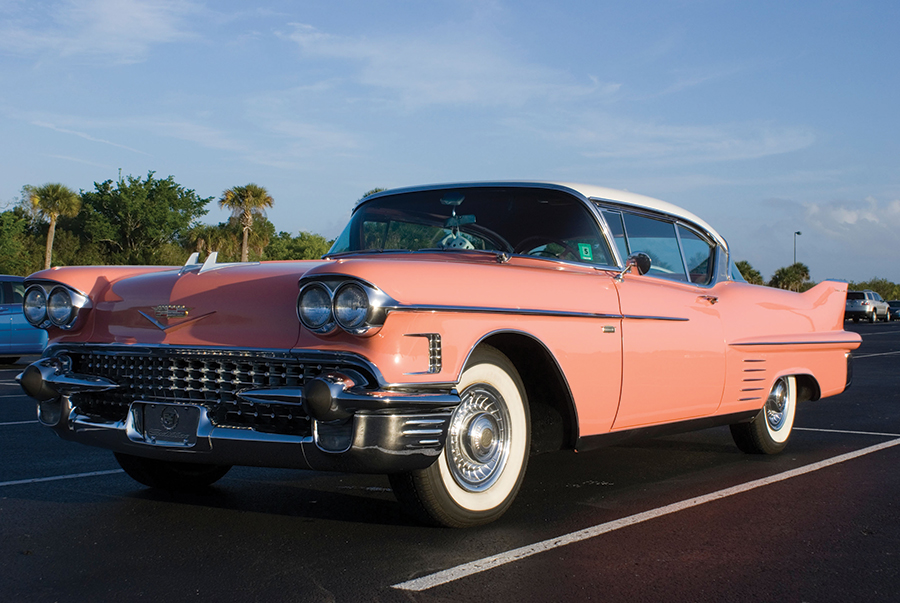
During the 1950’s, performance and styling became keys to selling. American cars grew longer, wider, and lower. Automatic transmissions became available in low-priced cars. Engine power and electric motors operated air conditioning, brakes, seats, steering, and the tops of convertibles.
By the late 1950’s, imports—especially the West German Volkswagen Beetle—began to take a growing share of the U.S. market. Imports reached 10 percent in 1959. They then temporarily declined until the late 1960’s.
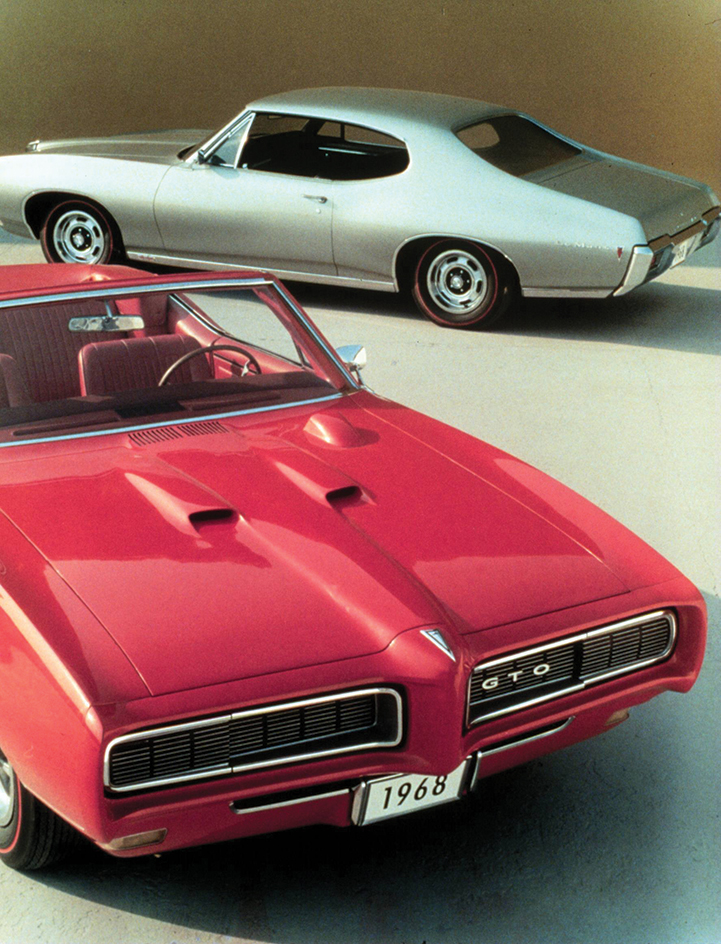
In 1964, Ford introduced the Mustang, which was smaller and sportier than most American cars. Car buyers loved the Mustang at first sight. The same year, Pontiac came out with the GTO, marking the era of the “muscle car” in the United States. Muscle cars were midsize cars with big, powerful engines, usually V-8’s. They were fast, but many were also unsafe due to inadequate brakes. The popularity of muscle cars faded by the 1970’s.
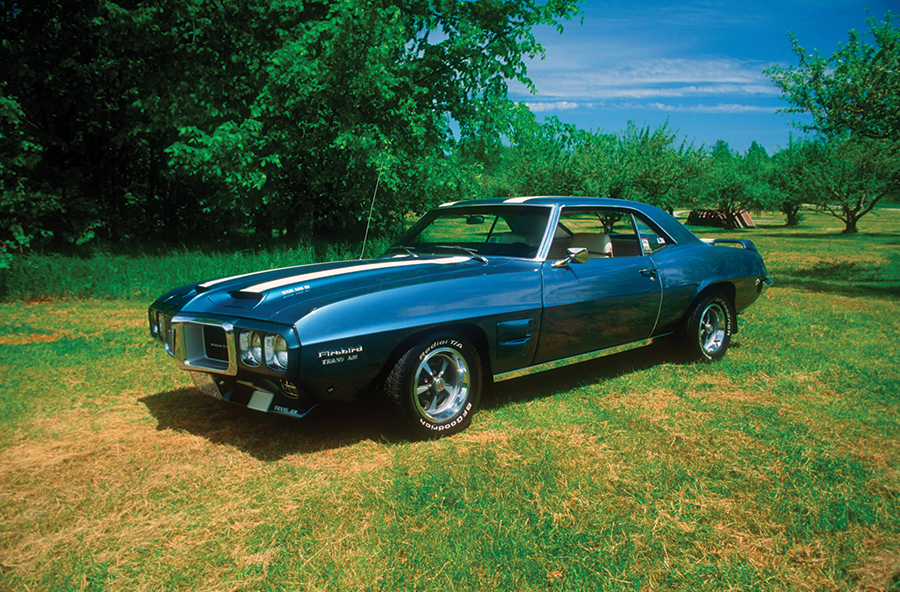
The growth of government regulation.
In 1965, an American lawyer named Ralph Nader wrote Unsafe at Any Speed. The book attacked Chevrolet’s Corvair in particular and the auto industry in general for emphasizing profits and style over safety. Corvair sales plunged, and Chevrolet stopped producing the car in 1969.
Until then, the U.S. auto industry had operated largely free of government regulation. The situation changed in the 1960’s, partly because criticism of the automobile had increased, especially after Nader’s book appeared. The 1966 National Traffic and Motor Vehicle Safety Act ordered certain changes to promote automobile safety.
The rise of international automaking.
During the 1960’s, the auto industries of France, Italy, Spain, Sweden, and West Germany prospered. The Soviet Union and Italy agreed to produce Italian Fiat cars in the U.S.S.R. The Australian auto industry thrived, and Argentina and Brazil expanded production. Japan, however, made the most dramatic progress. Japanese production skyrocketed from about 50,000 cars in 1958 to more than 2 million by 1968.
A worldwide petroleum shortage during the 1970’s resulted in high gasoline prices and long lines at filling stations. Many families with large automobiles switched to smaller, lightweight cars that were more fuel efficient. In the United States, imported cars became popular because of their fuel efficiency. By 1980, imports had captured more than 25 percent of the U.S. market, and Japanese cars accounted for more than 80 percent of those sales.
Challenges to the Big Three.
The oil shortage led the U.S. Congress to pass a law in 1975 requiring manufacturers to make cars more fuel efficient. The 1974 cars averaged 14 miles per gallon (6 kilometers per liter) of gasoline. Under the new law, the 1985 models had to average 27 1/2 miles per gallon (11.7 kilometers per liter). The Big Three met the requirements by building lighter cars with smaller engines and by making mechanical improvements. However, they could not match the Japanese automakers in quality. Congress later demanded even greater fuel efficiency in the 1990’s.
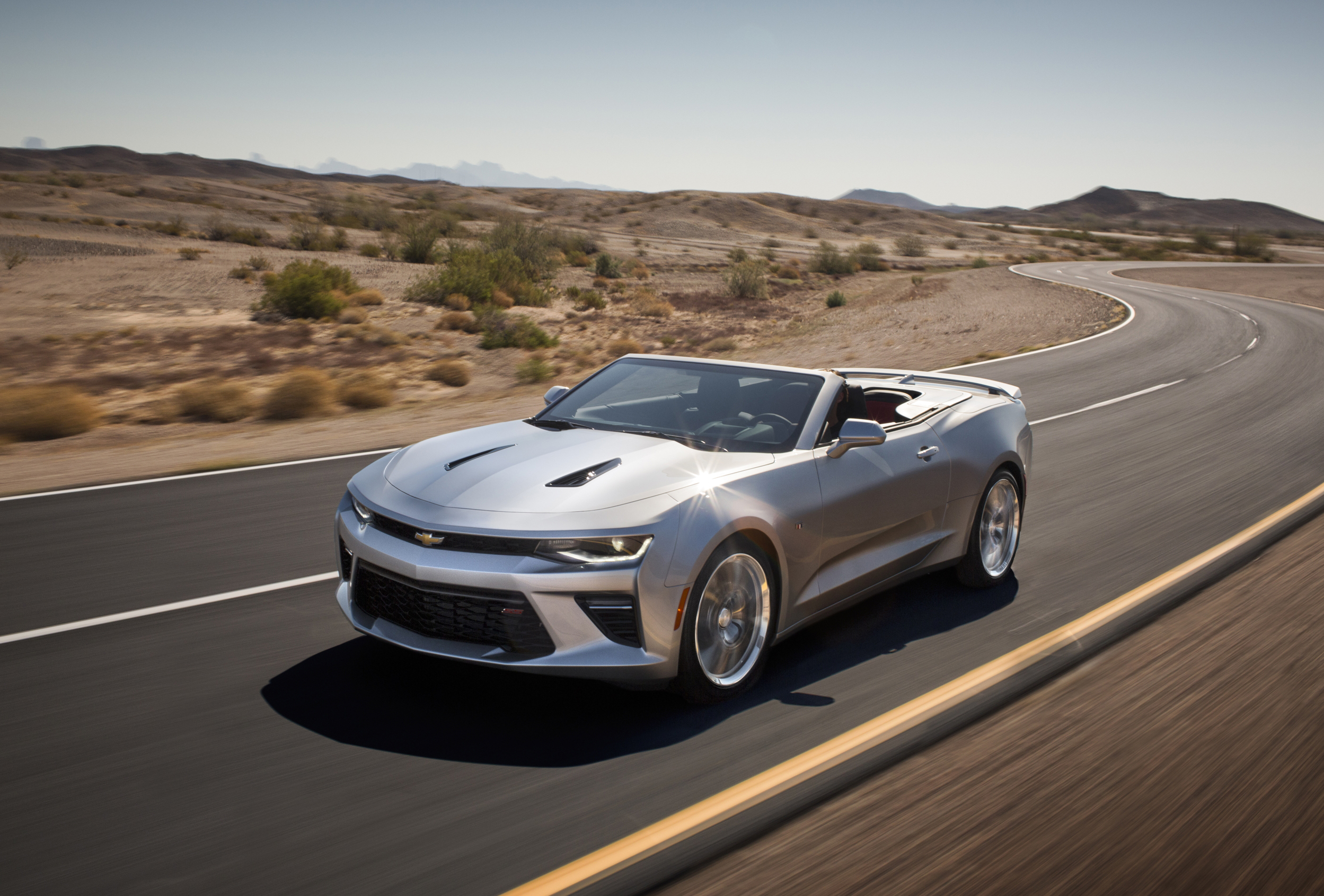
The shift in consumer preference from large cars to small ones helped Japan surpass the United States as the world’s largest automaker for the first time in 1980. The shiploads of imported cars pouring into the United States stunned the Big Three. The price of a new car rose sharply during the early 1980’s. As a result, people kept their old cars longer before buying a new one.
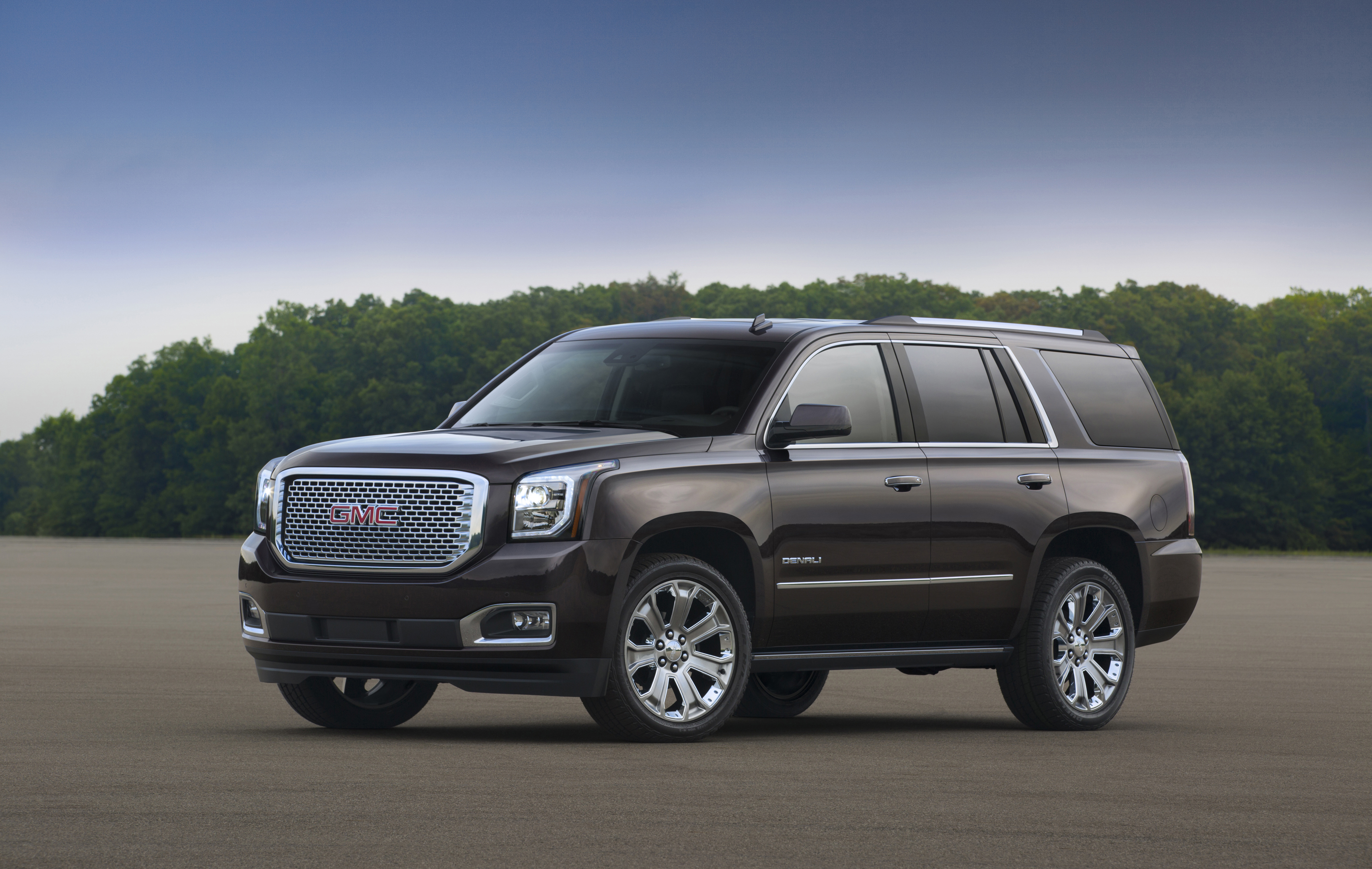
Chrysler, in deep financial trouble, needed $1 1/2 billion in government-guaranteed private loans to survive. Lee Iacocca, head of Chrysler, turned the company around for a time. Chrysler received the loans in 1980 and repaid them within three years. In 1984, Chrysler introduced a line of small passenger vans called minivans that achieved huge success in the marketplace. In 1987, the company bought American Motors Corporation, which the French automaker Renault had largely controlled since 1977.
In 1981, the U.S. and Japanese governments placed voluntary restrictions on the export of Japanese cars to the United States. The restrictions encouraged Japanese carmakers to produce vehicles in the United States themselves. By the late 1990’s, several Japanese manufacturers had assembly plants in the United States.
The 2000’s.
Light trucks and sturdy SUV’s became increasingly popular in the United States. In the 1990’s, U.S. production of such vehicles surpassed that of passenger cars. This shift toward big, fuel-hungry vehicles eventually created problems for U.S. automakers after a global recession began in 2007. As the economic downturn took hold, demand for vehicles dropped. American automakers struggled to survive. Chrysler and GM received billions of dollars in loans from the U.S. federal government. Despite these loans, both Chrysler and GM filed for bankruptcy in 2009. GM quickly emerged from bankruptcy, but Chrysler did not.
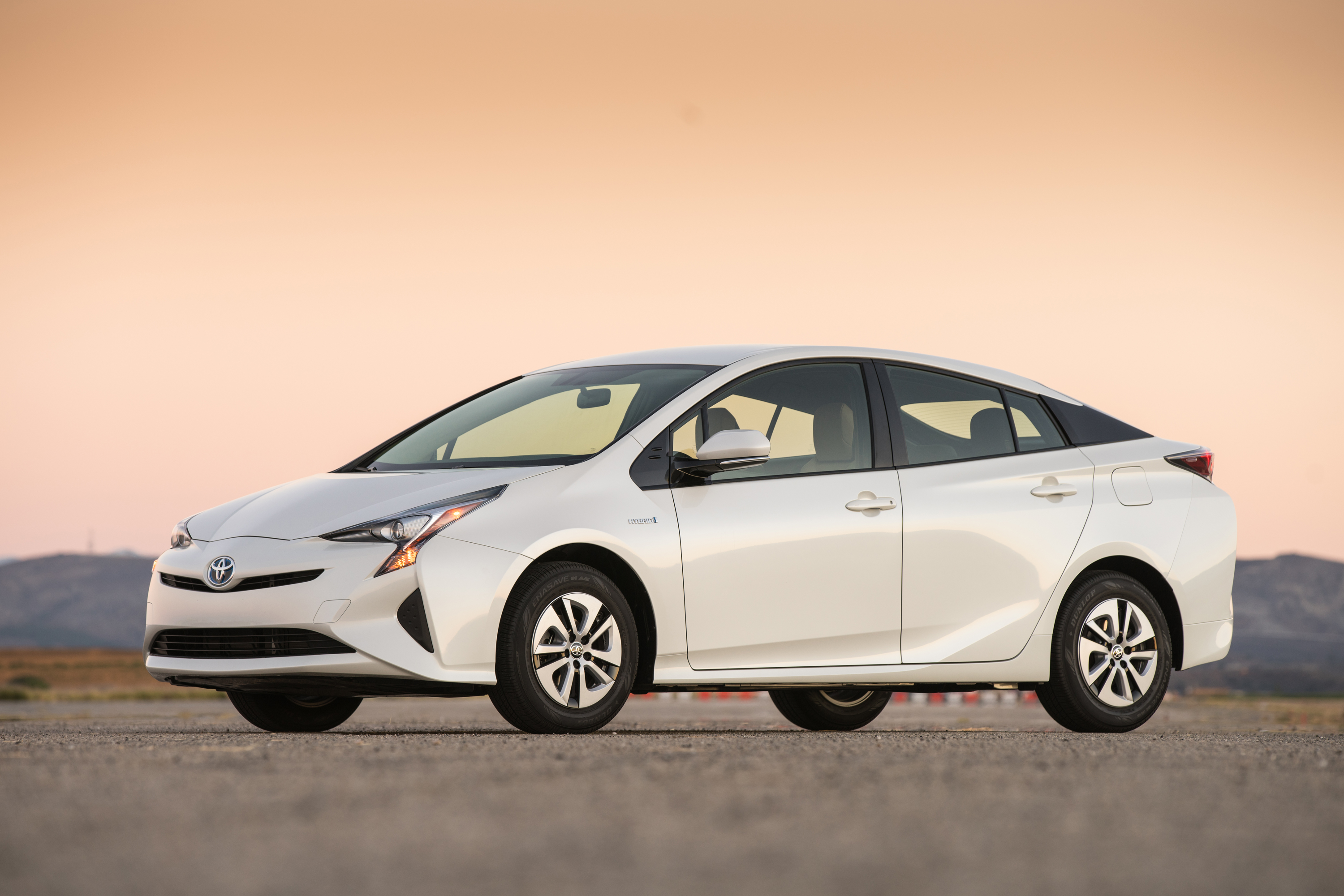
Gasoline prices soared in 2008, soon after the recession had begun. As a result, more consumers purchased fuel-efficient vehicles, including hybrids and electric cars. For example, the number of hybrid cars sold in the United States increased from about 8,000 in 2000 to about 290,000 in 2009. Manufacturers who made fuel-efficient cars also benefited from a U.S. government program called the Car Allowance Rebate System. The program, popularly known as “Cash for Clunkers,” gave car owners up to $4,500 for trading in older cars with poor gas mileage for newer, more fuel-efficient vehicles.
Rising gas prices also led to other efforts to reduce consumption. For example, engineers and scientists worked to power cars with fuel cells. Fuel cells convert chemical energy to electric energy, rather than burning gasoline. Some automobiles were manufactured to run on biofuels, including ethanol, a type of alcohol made from crops such as corn and sugar cane.
Despite technological advances, the auto industry faces many challenges. The industry still manufactures many large, inefficient vehicles, but rising fuel costs have made them less popular with consumers. Safety concerns have also caused problems. In 2010, the Japanese automaker Toyota Motor Company had to recall millions of vehicles because their gas pedals could become stuck, causing the cars to accelerate out of control.
